

How to Visit Amazon Jungle Peru – Everything You Need to Know
The Amazon Rainforest, often called the Amazon Jungle, is the largest rainforest on Earth.
It spans multiple countries in South America, including Brazil, Peru, Colombia, Venezuela, Ecuador, Bolivia, Guyana, Suriname, and French Guiana.
Hi, we’re Rach & Marty!
We’ve visited every country in the world and want to help you get the most out of your travels!
Whether you need an expertly planned itinerary , some experienced hints and tips , or just craving a delicious food adventure , we’ve got you covered!
We may earn affiliate commissions from websites we link to, at no cost to you. Click here for details.
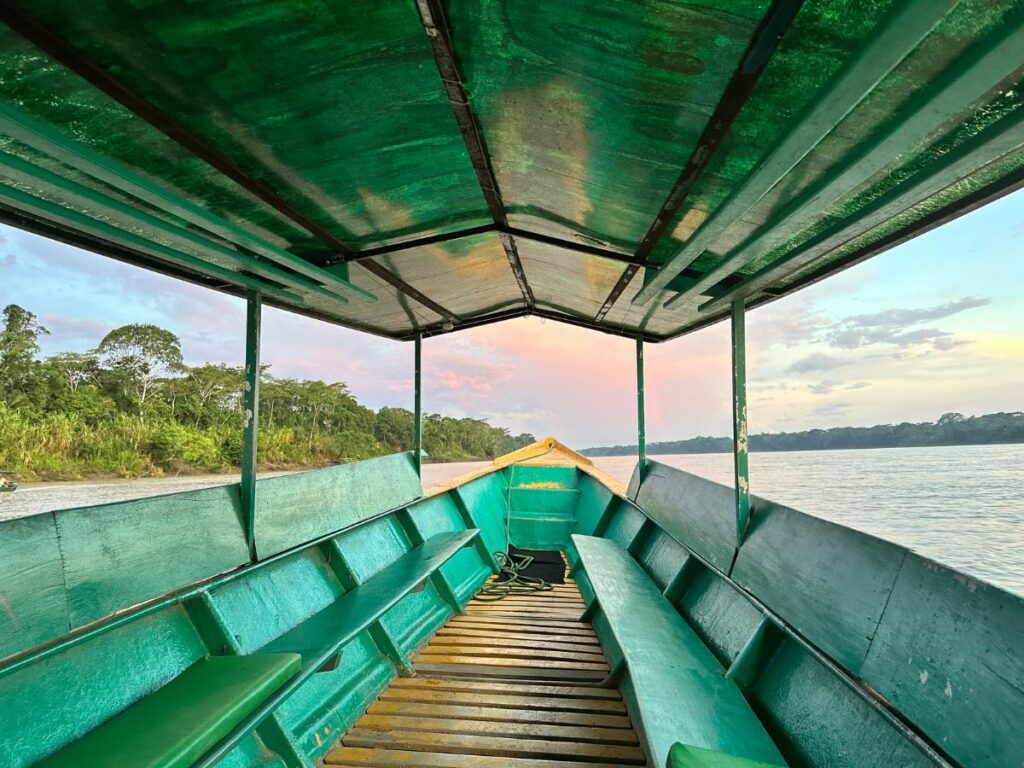
Visiting the Amazon Jungle had been on our bucket list for quite some time, so after spending the best 2 days in Lima , we arranged a side trip to the Amazon Jungle Peru.
To help you plan a visit to the Amazon, I’ve compiled this guide that includes our best travel tips, prices and details on visiting the Amazon Jungle in Peru.
Table of Contents
The Best Time to Go
Exploring the Amazon Rainforest is a year-round possibility, given its consistent weather conditions throughout the seasons. Anticipate warm, rainy, and humid weather, regardless of the time of year.
The wet season spans from January to June, featuring temperatures ranging from 23 to 30ºC (73 to 86ºF). Daily showers are a common occurrence, sometimes with substantial intensity.
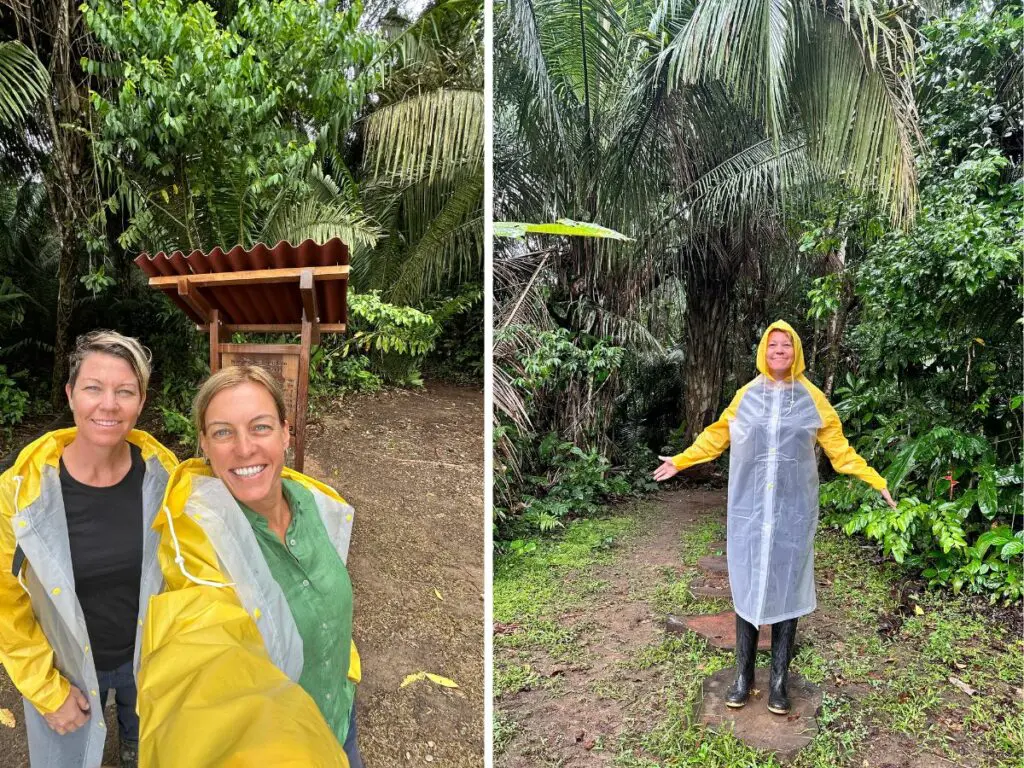
However, it’s important to note that the higher humidity during this period results in more mosquitoes.
The dry season, from July to December, includes the latter half of the year. During this period, temperatures average around 26 to 40ºC (78 to 104ºF). While there is less rain, occasional heavy showers can still occur. Reduced rainfall results in a drier atmosphere in the jungle and lower river levels.
This creates advantageous conditions for exploration on foot and provides an excellent chance to spot caimans as they contend for diminished food supplies.
The most popular time to visit the Amazon is in July and August. The height of water in the jungle is reasonable, and you have a higher chance of spotting more wildlife.
Where to Go And How to Get There
Two notable areas in the Peruvian Amazon jungle are popular for ecotourism and wildlife experiences.
- Iquitos, the largest city along the Amazon River in the Peru jungle, is the northern gateway to the Peruvian Amazon basin.
- Puerto Maldonado is a city in southeastern Peru in the Madre de Dios region, part of the Amazon rainforest. It serves as a gateway to the Tambopata and Manu National Reserves, two of the most biodiverse areas in the Amazon rainforest.
When planning your journey, there’s no rule on choosing the best area of the Amazon to visit, but you should consider your itinerary.
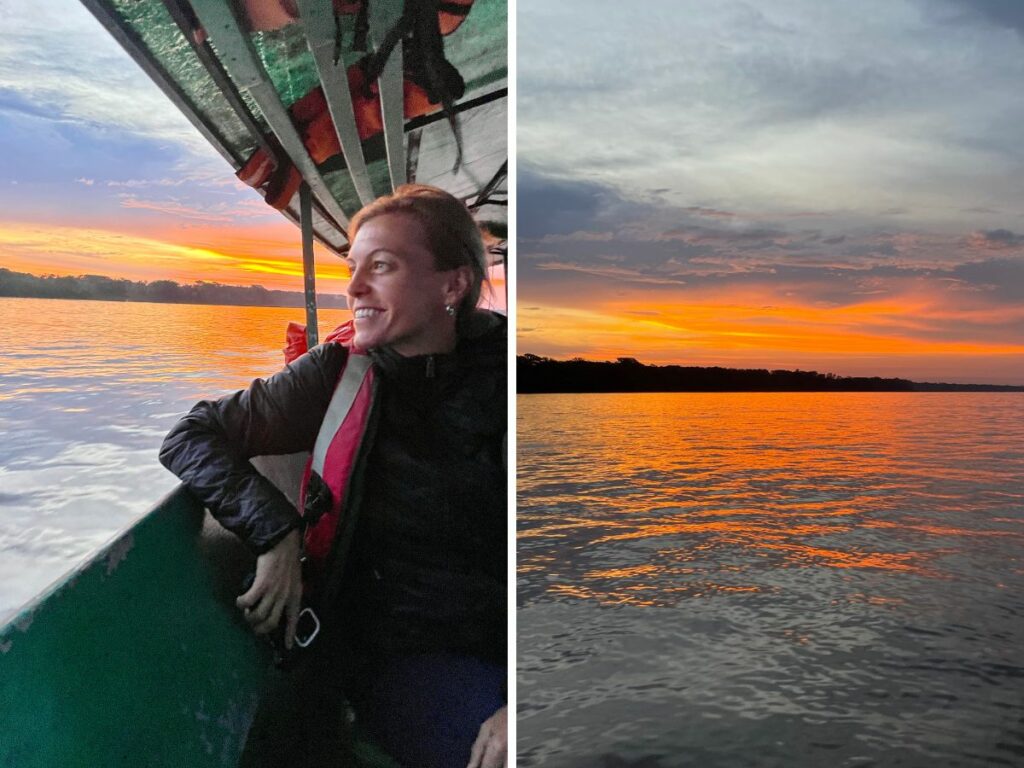
For instance, diverting to Iquitos might be impractical if you travel to Cusco or Lima. Instead, destinations like Manu National Park or Puerto Maldonado, the entry point to the Amazon rainforest, are closer and logistically make sense.
You can book a flight to Iquitos or Puerto Maldonado from Lima or Cusco. You can also take a bus from Cusco to reach these cities to begin your Amazon Jungle experience; this is the most affordable option.
While visiting Lima, we booked this 3 Day Jungle Tour to explore the Tambopata National Reserve.
We started our Amazon Jungle trip by booking a flight from Lima to Puerto Maldonado on Skyscanner and found the price of flights to be very reasonable.
The Perfect Itinerary for 2 Days in Lima
How Many Days Do You Need in the Amazon Jungle Peru
We’d recommend setting aside a minimum of three days to visit the Amazon Jungle in Peru.
In this timeframe, you can embark on several excursions that provide a glimpse into the captivating offerings of this region.
The most popular Amazon Jungle packages are 3 or 4 nights
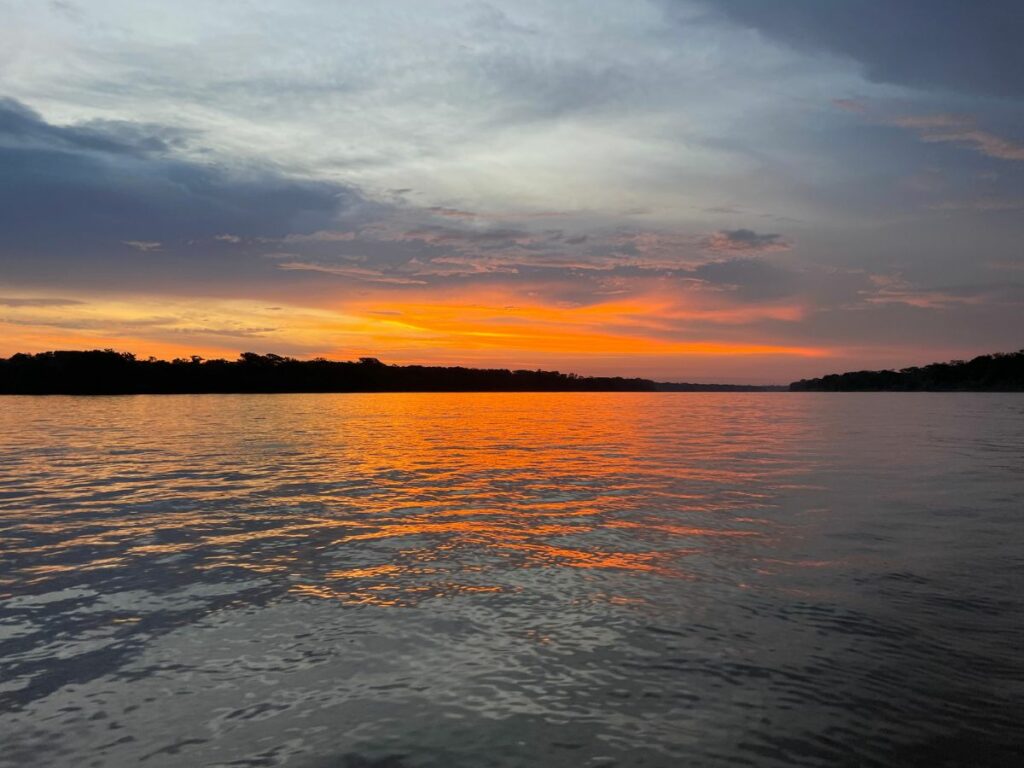
Travelling to a country with a different currency? Avoid ATM transaction fees and pay in local currency with a Wise Card . We love this card; it has saved us so much in fees.
Book A Tour or Travel Independently
We usually travel independently and book logistics as we go; however, after crunching numbers and working out the logistics of getting around in the Amazon Jungle in Peru, we found that it was much easier and more economical for us to book a packaged tour.
There are many tour operators to choose from online. After comparing many options, we decided to book this 3 Day/2 Night Amazon Jungle trip as it’s a Peruvian-owned company with excellent reviews from past guests.
For this complete package, including airport transfers, 2 nights’ accommodation in a bungalow Garden Lodge (with private ensuite facilities), all meals, drinking water, activities and a local guide, we paid approximately USD 350 per person, as we booked a nicer room with private facilities.
VIEW this 3D/2N Amazon Jungle Tour
- 🔥 Hot Tip: Book accommodation on Booking.com
- 🎟 Book your tickets online: We use Viator and GetYourGuide
- 🔋 Stay charged: This Belkin Power Bank is essential!
- 📸 Join a Group Tour: View our tours OR search Tourradar
- ✅ Get Connected with eSIM: Easy and affordable! View eSIM
Where To Stay
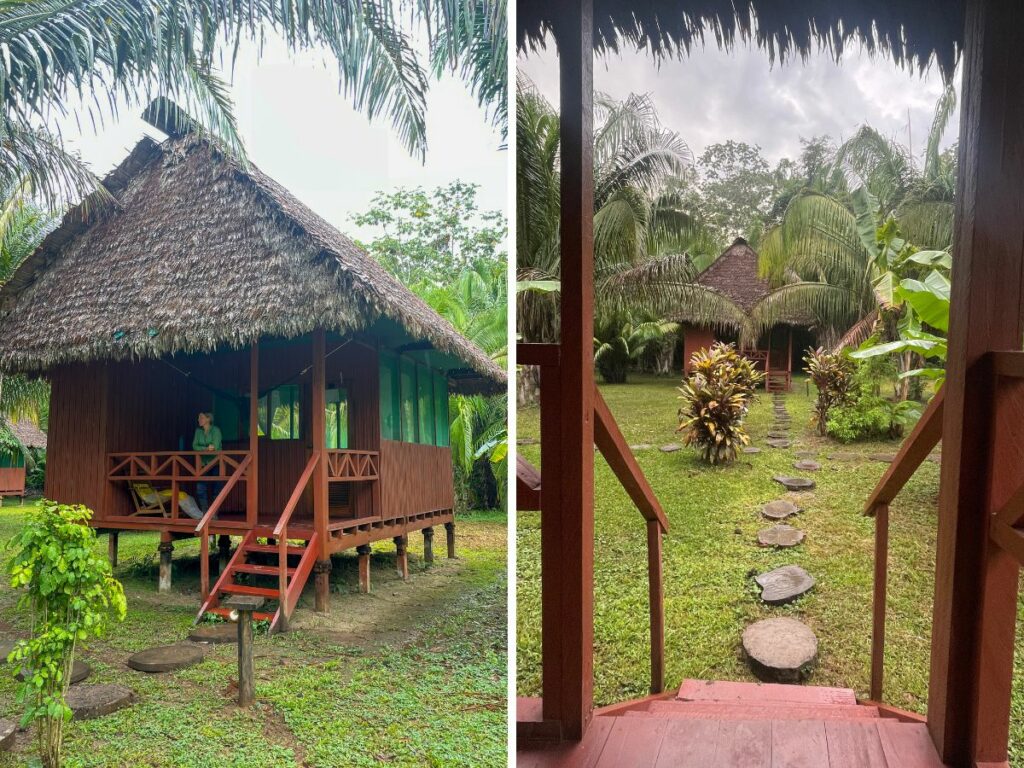
The overall accommodation style in the Amazon Jungle Peru is typically jungle lodges in various regions.
The choice is up to you whether you opt for a remarkably luxurious or more basic option. You can expect comfortable accommodations in these lodges, usually in twin-share or double cabins with attached ensuite bathrooms.
It’s important to remember that your lodge is in a remote location, so electricity may only be available for specific hours during the day. This was the case with our lodge, so whenever electricity was available, take the opportunity to charge your phone, cameras etc.
The rooms have mosquito nets and fans to ensure a cool and protected night’s sleep.
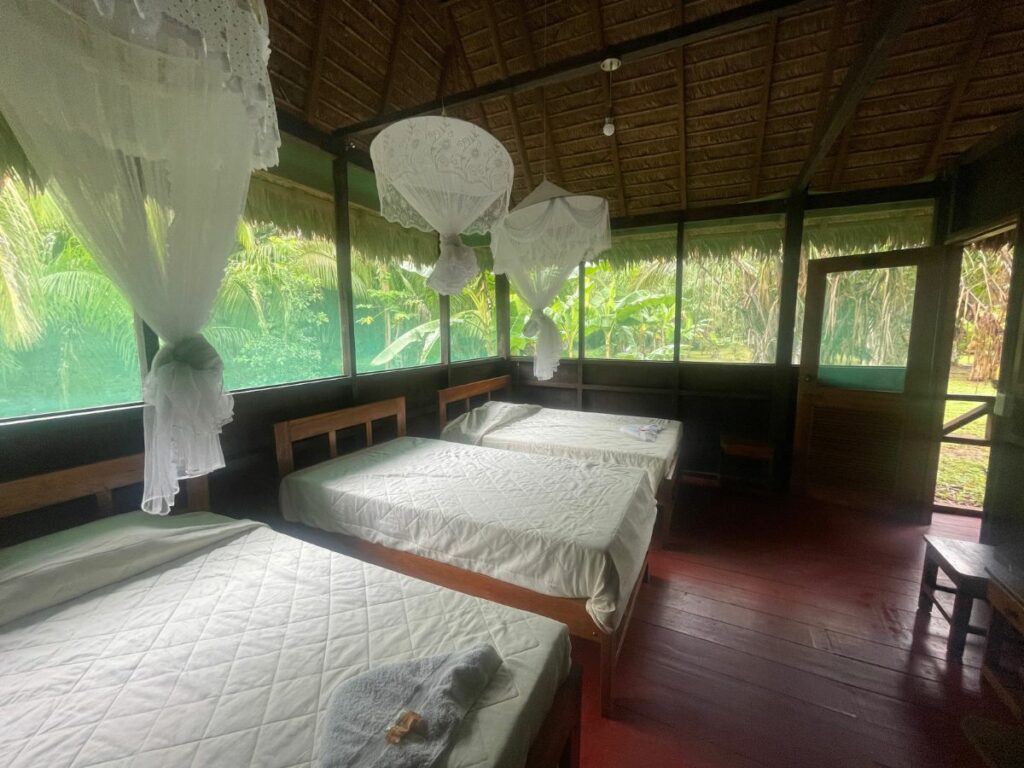
You may choose a bungalow accommodation with shared bathroom facilities for those travelling on a budget.
Most of the lodges are within a 1-1.5 hour boat ride from Puerto Maldonado Boat Pier.
Accommodation providers usually offer all-inclusive packages that include transfers from Puerto Maldonado airport, accommodation, all meals, and several daily excursions.
Amazon Jungle Lodges in Peru
Numerous jungle lodges are situated along the river, ranging from inexpensive ones with very basic amenities to more stylish lodges with comfortable bungalows.
Here are my top picks for Amazon jungle lodges for varying budgets:
BUDGET: Hacienda Herrera Tambopata – Offering garden views, this property provides accommodation, a garden and a terrace. Pick up and drop off from airport or bus station is provided for free, has to contact property for arrengments. Is a 20 min boat ride from El Triunfo Port to the lodge.
MID-RANGE: Amazon Planet – A true ecolodge within a protected area surrounded by rainforest and wild animals in their natural habitat. Free airport transfers, river transfers, all meals are included. Jungle excursions and adventure activities in the area such as treking, biking, fishing, and boat rides can be arranged.
Full program itineraries are available for an add-on rate. The rooms in Amazon Planet feature private bathrooms and terraces. Breakfast is served daily. The on-site restaurant offers a daily menu and can cater to special diets upon request.
LUXURY: Inkaterra Reserva Amazonica – Located in the Peru Amazon Jungle, this hotel features tours to the rainforest, a massage spa overlooking the Madre de Dios forest and rooms with hammocks and balconies. Breakfast, lunch, and dinner are included in the rates.
There are eco-friendly bathroom amenities and private bathrooms. The hotel is a 45-minute boat ride from Puerto Maldonado. Cusco is a 25-minute flight away.
View ALL Lodge Accommodation in Tambopata National Reserve
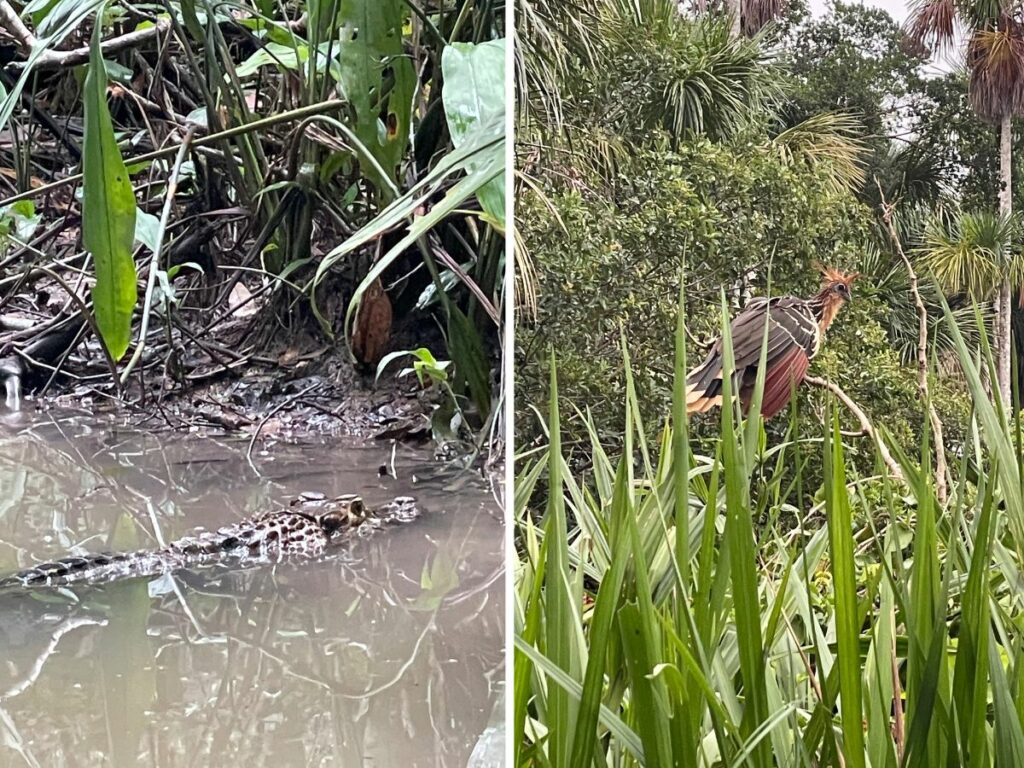
9 Weird Drinks In The World That Will Surprise You
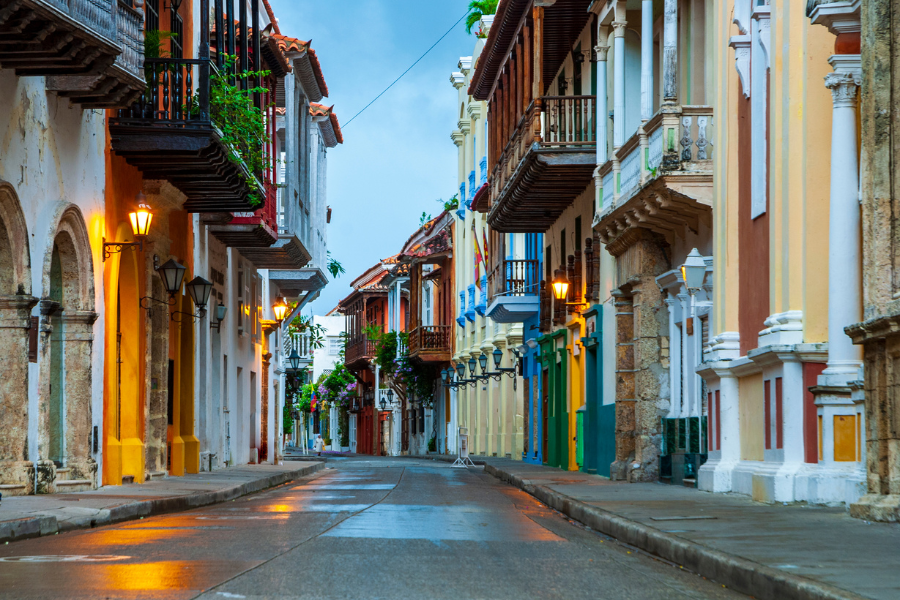
15 of The Best Places to Visit in South America
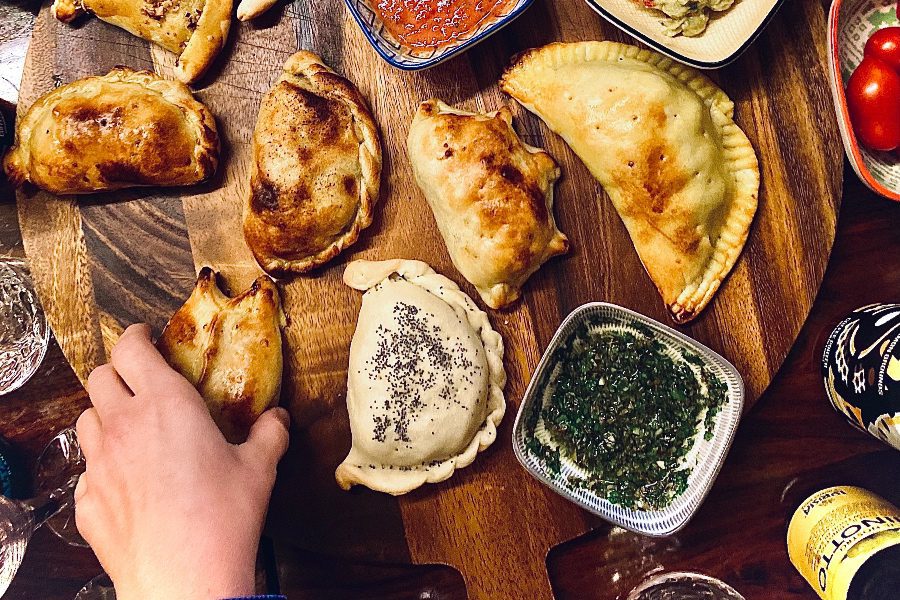
Top 5 Popular Foods in South America
What You Can See in the Amazon Jungle in Peru
The Amazon jungle in Peru is like a vast garden with many plants. You’ll find towering trees, like the Ceiba and Kapok, that stand really tall. Some trees, like the rubber tree, have been essential for making rubber.
There are plants that people have used for medicine for a long time, like the Cinchona tree, which helps treat malaria, and the Cat’s Claw, which indigenous communities have used traditionally.
On the trees, you’ll see colourful plants called bromeliads and orchids. Palms, like the Açaí and Assai, give us tasty fruits.
Vines and climbers, such as the vanilla orchid and passionflower, make the forest look even more beautiful. All these plants create a rich and amazing environment in the Peruvian Amazon rainforest.
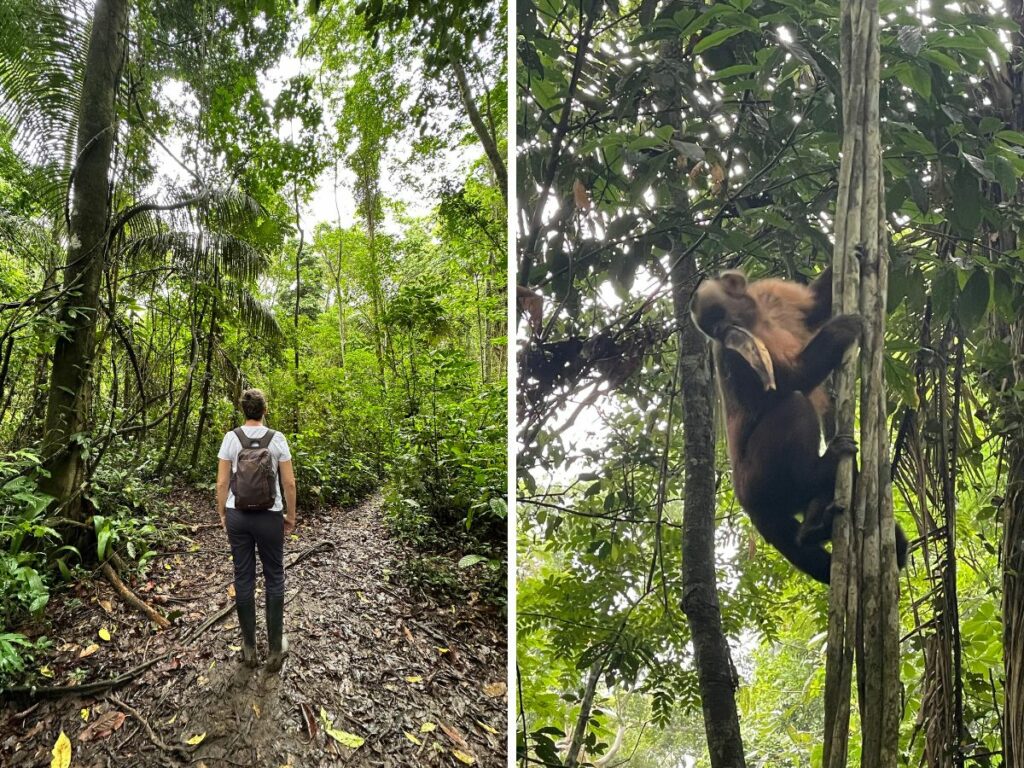
The most commonly seen animals in the Amazon jungle are monkeys (squirrel monkeys and howler monkeys), caimans, sloths, frogs, tarantulas, piranhas, and birds such as herons, and the hoatzin (stink bird).
If you’re fortunate, you may see the endangered giant otter.
Of course, the frequency and proximity of wildlife sightings often depend on luck when exploring the Amazon Jungle.
Nonetheless, it remains a fantastic destination with ample opportunities to encounter and observe various forms of wildlife.

Activities in the Peruvian Amazon Jungle
With its distinctive geography and captivating flora and fauna, the Amazon Jungle in Peru offers some incredible places to visit and activities to engage in.
Here are some of the best ways to explore and appreciate this region and its wonders.
Jungle Walk: Take a trek through the rainforest accompanied by your guide, who will showcase and educate you about a diverse array of exotic plants and wildlife.
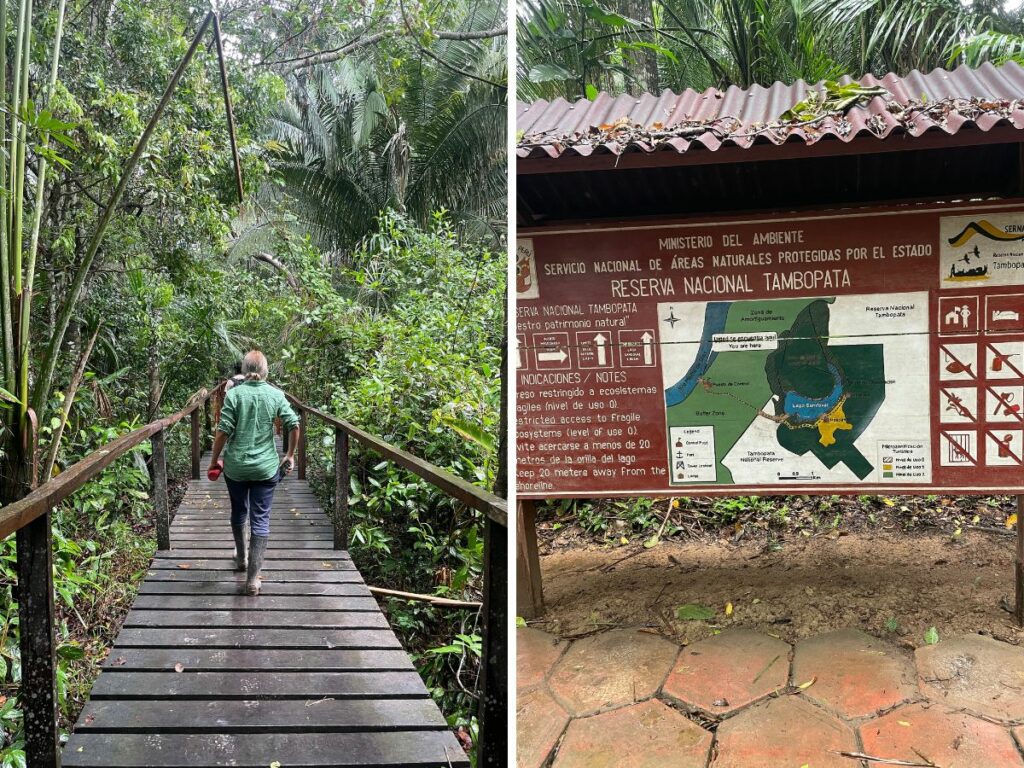
Go Kayaking on the River: Explore the calm waters of small rivers and lakes with a kayak, offering opportunities to observe caimans and various birds.
Go Fishing: Drop in a line and see if you can catch dinner! Don’t expect to catch a large fish, but it’s a fun activity, and you can enjoy a spot of birdwatching at the same time.
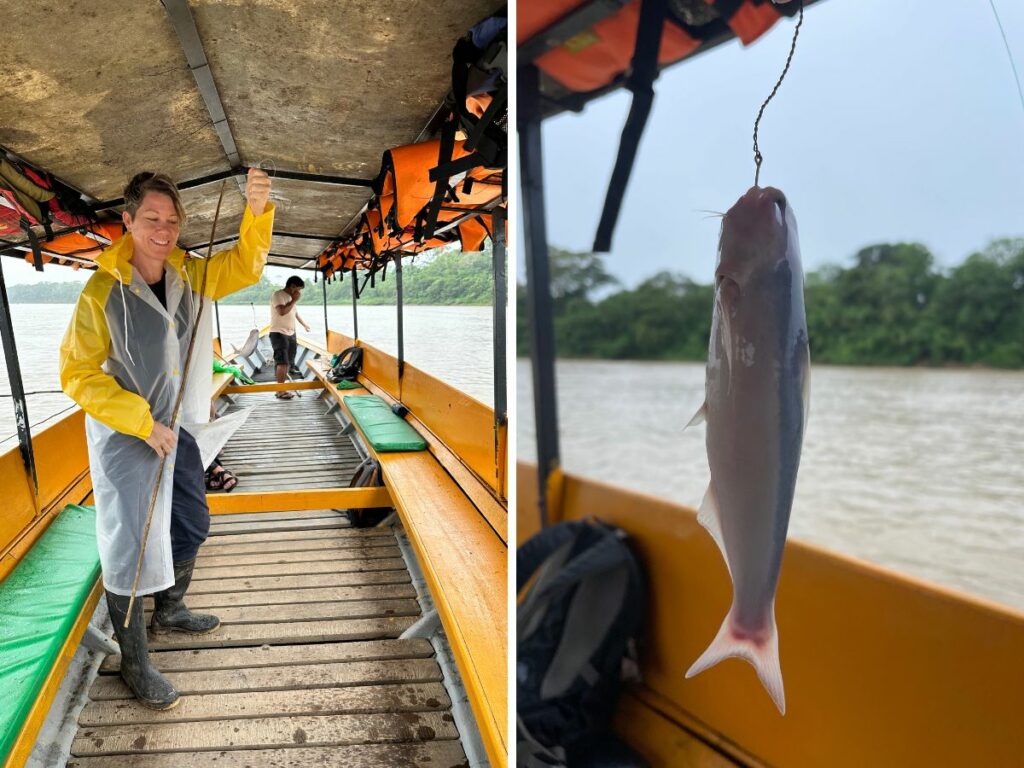
Discover Lake Sandoval: Visit Lake Sandoval, which is located in the Tambopata National Reserve. Hike 3 km through the park to reach the shores of Lake Sandoval.
Ride on a paddle boat on the lake and look for birds such as hoatzins, monkeys, and various flora. This activity was a real highlight of our trip to the Amazon Jungle in Peru.
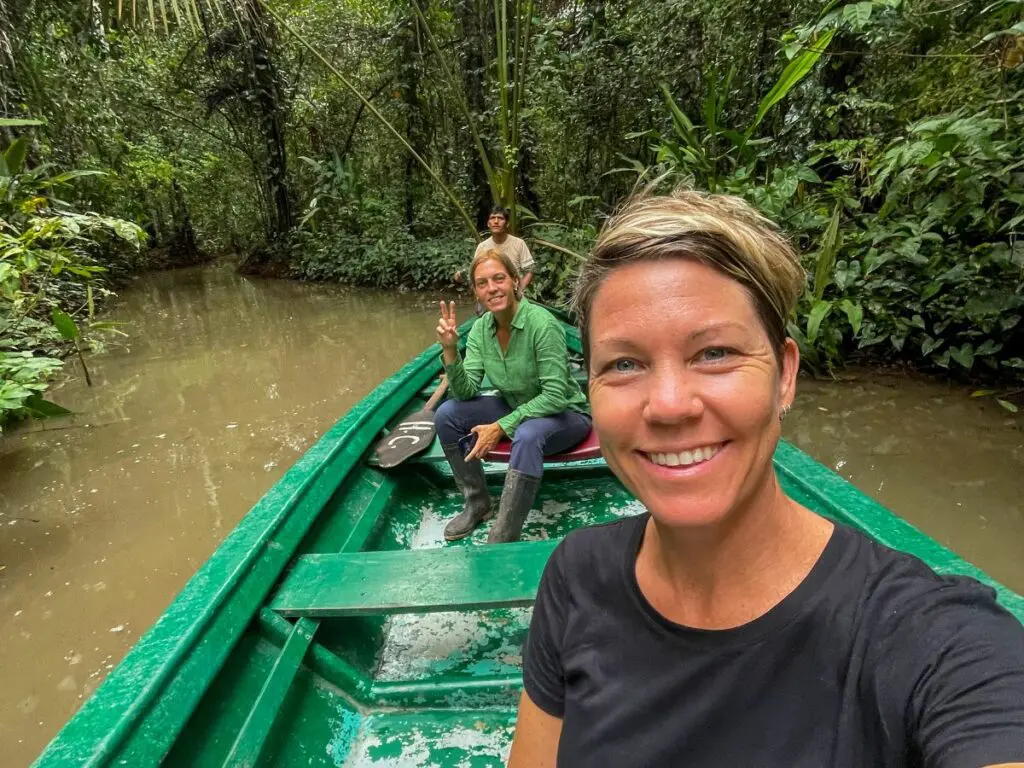
Make sure you get Travel Insurance before hitting the road. We recommend Heymondo & SafetyWing
Click here and get 5% off Heymondo from us!
What to Pack for Amazon Jungle in Peru
We recommend packing some lightweight, moisture-wicking clothing, and you will need a waterproof jacket (or poncho ); plus, it’s worth considering waterproof pants .
TIP: Dress in light, neutral colours to avoid mosquitoes.
Trousers and long sleeves are necessary when taking jungle walks to protect yourself from mosquitoes and spikey plants.
Add the following items to your packing list:
- A head torch for night walks through the jungle.
- Binoculars for a closer look at the Amazon wildlife.
- A good power bank to charge your electronics, as electricity is limited.
- Mosquito repellent is essential whether you travel in the wet or dry season.
- Practical walking or trekking shoes , although rubber gumboots are usually provided.
- A wide-brimmed hat to protect your head from the sun during river cruises.
- Sunscreen – it gets scorching in the Amazon Jungle.
- A reusable water bottle to keep hydrated. Your accommodation provider will provide drinking water during your stay.
- A good book – View our recommendations for great travel books .
Get Connected with eSIM

Get connected easily on your travels—buy an eSIM! It works like an app: buy it, download it, and get connected in minutes! It’s easy, affordable, and convenient. Keep your original phone number, too!
Use our code: RACHEL5045 to get $3 off your first purchase!
Recommended Tours to the Amazon Jungle in Peru
Check out these top-rated tours below for those who prefer to reserve everything in advance.
We hope you enjoyed reading more about how to visit the Amazon Jungle in Peru. Have you visited the Peruvian Amazon? Would you add any tips to this guide? Please let us know in the comments below.
If you’re heading to Buenos Aires in Argentina (and we highly recommend you do), this 2 Days in Buenos Aires Itinerary is essential to read.
Don’t forget to check out these 16 Best Restaurants in Buenos Aires ; what an excellent food city!
Travel Tips for South America
We have many travel guides and tips for South America—a colourful and vibrant continent!
We believe these are the 15 best places to visit in South America.
Are you travelling on a budget? These five cheapest countries in South America will help you plan an itinerary that lets you see as much as possible.
Furthermore, if you plan to travel long-term (or at least until the money runs out), these 21 cheapest countries to visit will help you make your hard-earned dollars stretch a bit further.
Delicious cuisine can be enjoyed across South America. There’s Colombian cuisine , Venezuelan food , the food in the Dominican Republic , Brazilian cuisine , and even Guyanese cuisine to inspire you on your culinary journey.
For food lovers, don’t miss our top 10 best countries for food.
Would you like some suggestions for packing for your South American adventure? Our ultimate packing list for travellers has you covered for the essentials.
These top 6 travel hacks to save money are great to read when planning your travels. Try these 5 popular foods in South America ; they’re delicious!
You’ll need to stay connected while travelling in South America. We recommend eSIM. It’s easy, reliable and affordable. View eSIMs for individual countries , or consider a regional eSIM for Latin America (which covers 19 countries).
If your travels in Latin America are part of a much larger global adventure, then a Global eSIM may be the answer. It connects you in 124 countries , offering data-only eSIM and data/call/text eSIM . The Global eSIM has been a game-changer; we couldn’t imagine travelling without it now.
If you want to travel with like-minded travellers, consider joining a group tour. Check out our Group Tours first for any upcoming departures in Latin America, or view Tourradar deals on group tours in Latin America .
Check out our best-ever travel tips compiled from more than twenty years of experience.
Travel Planning Resources
✈️ Flights : We use Skyscanner to book cheap flights worldwide.
🏨 Accommodation : Booking.com is our preferred platform for booking hotels and accommodation. We use Vrbo to book apartments and long-term stays.
🏥 Travel Insurance : We recommend Heymondo ( Get 5% off Heymondo) & SafetyWing
🚌 Transportation : Trainline is the best website to reserve trains. We use Omio to book transport worldwide. For travel in Asia, we use 12Go.
🚘 Car Rental : We use DiscoverCars to book rental cars worldwide.
👫 Group Tours : We now offer Group Trips; check them out here . Alternatively, we recommend G Adventures OR Tourradar .
📸 Day Tours & Trips : GetYourGuide & Viator are the only two platforms you need.
📚 Lonely Planet: The Best Range of Travel Guides & Ebooks , and FREE Shipping! (use code RACHELDAVEY10 for a 10% discount)
🎒 Luggage : Osprey Farpoint 40L Backpack or Samsonite Luggage Range.
🛄 What to Pack: Don’t forget your Universal charger and a good power bank . To help you pack the essentials, here is our ULTIMATE Packing List for all Travellers .
🐶 Become a House Sitter: Join Trusted Housesitters and enjoy FREE accommodation worldwide. Use our invite to receive 25% off your new membership.
💰 Send Money Anywhere: WISE & Revolut are the best online accounts that let you send money, get paid, and spend money internationally. Both are so easy to use and way cheaper than any bank transfer.
📶 Stay Connected: Airalo eSIM allows you to get connected the moment you land at your destination, and you can avoid those expensive data roaming charges. We LOVE this product! Use promo code NOMAD15 for 15% off ALL eSIMs (new Airalo users only) OR use NOMAD10 for 10% off ALL eSIMs (for existing Airalo users)
✅ Check out our Travel Gear and Travel Resources for more valuable tips to save you money!
Tasty Food Adventures

Top 10 Best Places to Eat on Magnetic Island

The Best Thai Food You Need to Try – 12 Top Dishes

Top 10 Most Delicious Foods from Iran

Food in Ukraine – 10 Most Popular Dishes
See all Food Adventure blogs
Expert Travel Guides
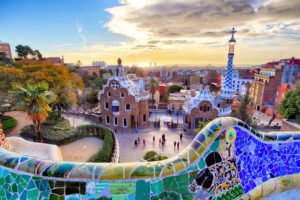
The Best City to Visit in Spain – 10 Top Rated Cities
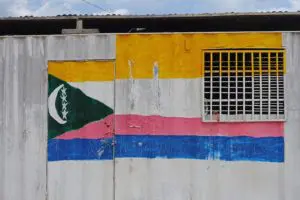
Where is Comoros Located?
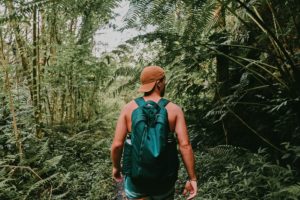
Southeast Asia Packing List – ULTIMATE Guide for 2024
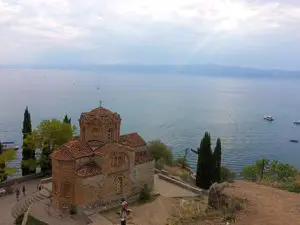
Visit Lake Ohrid – 7 Best Things to See and Do
See all our Travel Guides
Trusted Hints & Tips

Australia to Europe CHEAP FLIGHTS from A$624

How Many Countries In The World Are There? Best Answer: 193!

How to Avoid 6 Common Tourist Scams in China

How to Travel Europe with Train in 2024 – Our Best Tips
See all our expert Hints & Tips
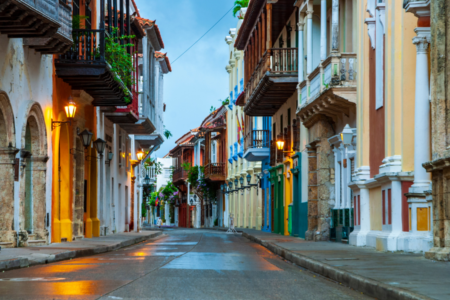
The Perfect 2 Days in Lima Itinerary
Leave a reply cancel reply.
Your email address will not be published. Required fields are marked *
Post Comment

How to Visit the Amazon in Peru: Ultimate Guide for 2024
Are you planning your trip to the Amazon in Peru? Wondering how to visit and where to go?
If you only have one chance to experience the Amazon rainforest, you want to do it right. But there’s a lot to figure out, and it can be overwhelming.
That’s where I come in.
I spent a week exploring the Peruvian Amazon – this was after I visited (and camped in) the Bolivian Amazon . I had the full Amazon experience, from meeting the local communities that call the Amazon home to seeing the diverse wildlife that lives in its forests and rivers.
I’m now sharing everything I learned in this detailed guide on how to visit the Amazon in Peru. It covers what you need to know and tips for planning your adventure.
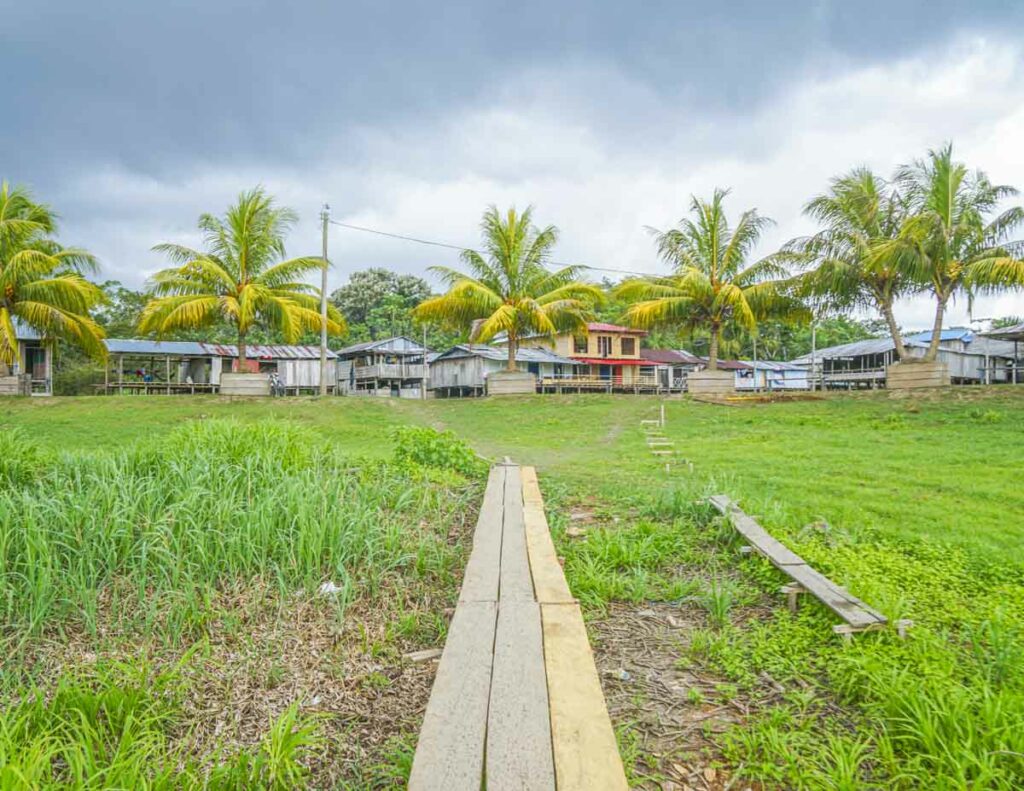
Quick Navigation
Where to see the Amazon in Peru
There are a few places where you can visit the Amazon.
- Iquitos: This is the best place to see the Amazon in Peru as you’ll experience nature, wildlife, and culture. Located northeast of the country, Iquitos is only accessible by boat or air.
- Manu National Park: This is part of the southern Amazon basin and is accessible from Cusco. It’s a full-day journey to get to, but you’ll get a wilder experience here.
- Tambopata National Reserve: This is a convenient option if you visit Cusco and only have a few extra days to see the Amazon. You’ll fly into Puerto Maldonado and take a short ride to your jungle lodge.
If I had to choose the best place to visit the Amazon in Peru, it’s Iquitos. But logistically, it can be difficult to get to if you’re coming from Cusco. There are no direct flights, and you’ll have to transit in Lima first.
This is why many people visit either Tambopata National Reserve or Manu National Park, both of which are easier (and cheaper) to get to from Cusco.
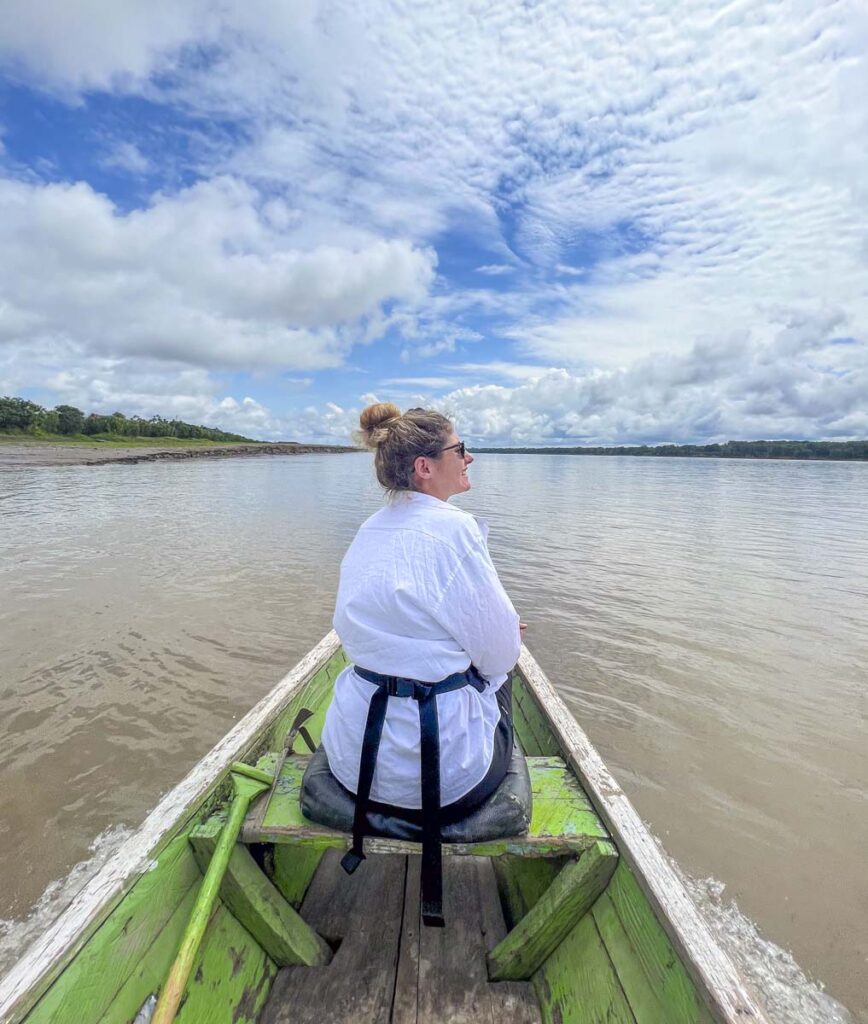
Best time to visit the Peruvian Amazon
There is a striking contrast between the dry and wet seasons in the Amazon. The best time to visit is during the dry season, from May to October.
During the dry season (between May and October), the conditions are ideal for trekking through the jungle. You’ll also be able to explore the river by boat.
However, just because it’s the dry season doesn’t mean it won’t rain. It is the Amazon Rainforest, after all! Expect the occasional rain shower, but nothing like you’d experience during the wet season.
I visited the Peruvian Amazon in July and highly recommend this time of year. From my experience, it was warm and slightly humid, but nothing like you would find during the wet season.
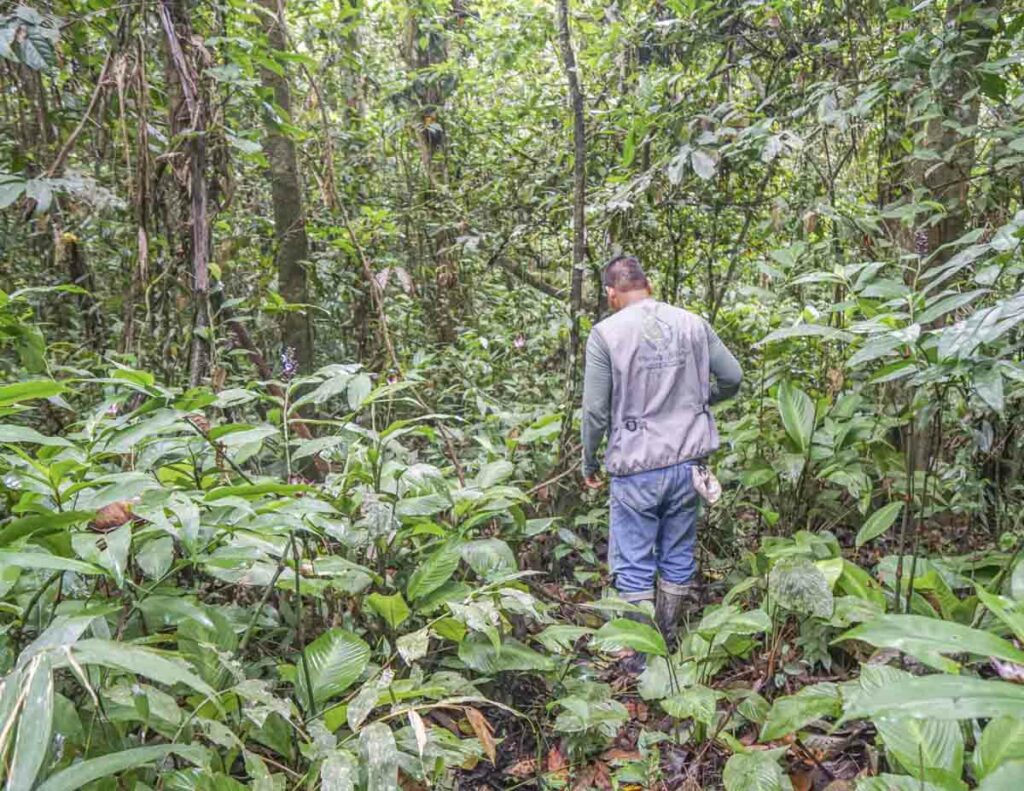
In the rainy season (December to April), you can expect a lot more mosquitos, higher levels of humidity, and daily rain showers.
The water levels are much higher, and many trails are underwater. This means you won’t do as much trekking through the jungle. Instead, you’ll do more boat-based activities.
Avoid visiting the Peruvian Amazon Jungle in January, February, and March if possible. These are the rainiest months. Mosquitos are also at their peak during this time which can be unpleasant.
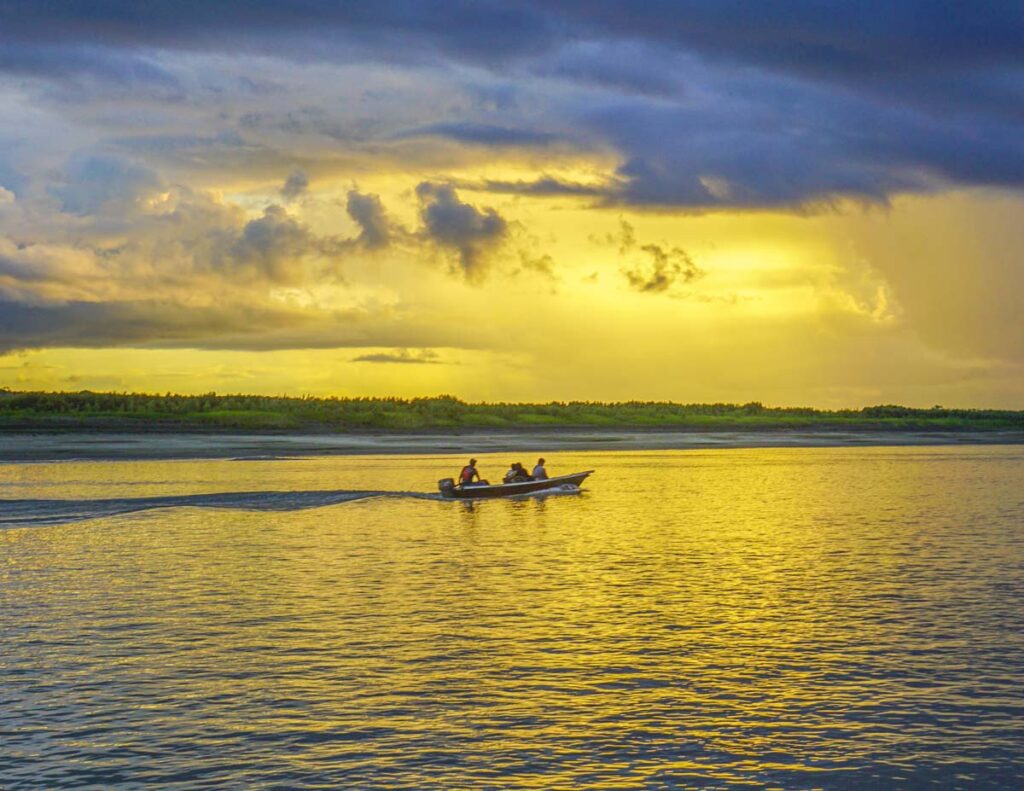
How to get to the Amazon
There are three main entry points to the Amazon in Peru: Iquitos (in the northern part of the country). Or Manu National Park and Tambopata National Reserve ( in the southern part).
Note: If it’s the Amazon River you want to see, you’ll need to go north to Iquitos. While Manu National Park and Tambopata National Reserve are part of the Amazon Rainforest, they do not have the Amazon River flowing through them.
- Best from: Lima
- Time recommended: 4 to 6 days
Iquitos is the primary gateway to the Amazon in Peru. It’s the largest city in the world that cannot be reached by road; the only access is by air or boat on the Amazon River.
There’s a hive of activity here and the city is where you’ll find the best Amazon tours. These tours depart from Iquitos, and you’ll drive by car (or go by boat) for a few hours before reaching one of the many smaller villages that line the banks of the Amazon River.
Here, you’ll stay in jungle lodges surrounded by local communities completely detached from the outside world. This offers a unique perspective on daily life in the Amazon – I was fascinated by it all.
Iquitos is also the best place to visit if you want to do an Amazon River cruise in Peru. There are various options to choose from, but the luxury cruises are quite something!
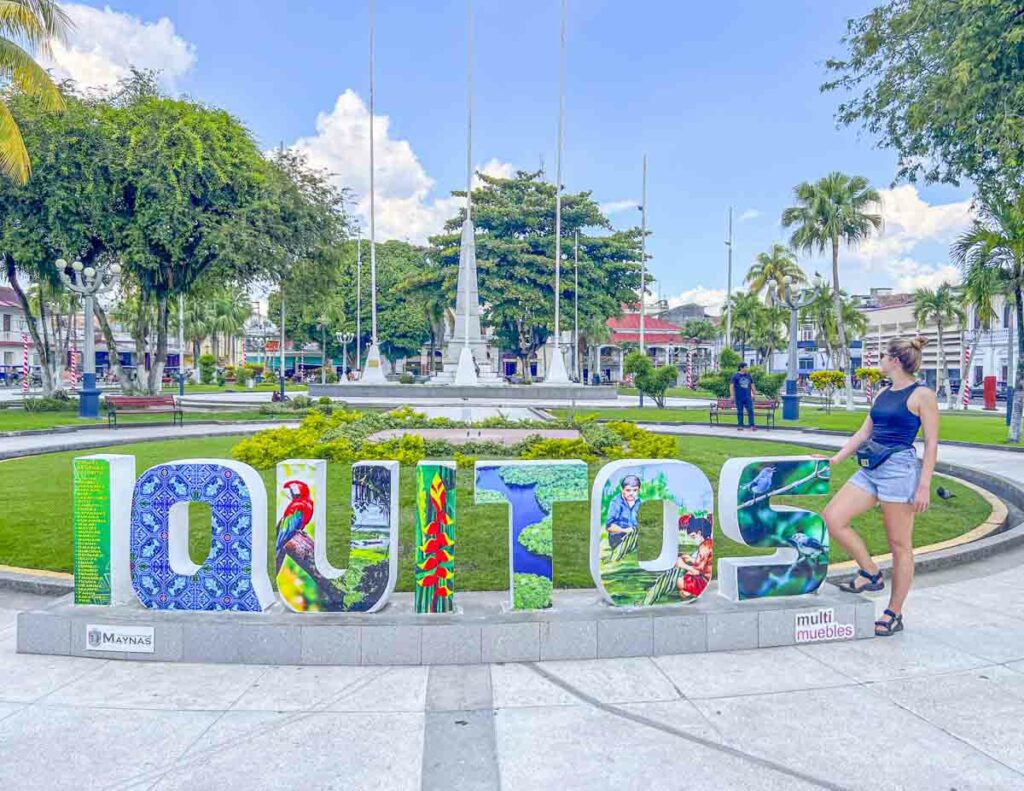
How to get to Iquitos
There are daily flights from Lima to Iquitos with Sky Airline or Latam. This 2-hour flight is the best and cheapest way to get here.
Unfortunately, there are no direct flights from Cusco to Iquitos. If you’re coming from Cusco (which is what I did), then you’ll need to fly to Lima first and catch another flight to Iquitos.
2. Manu National Park
- Best from: Cusco
Manu National Park is a great place to visit the Amazon in Peru if you’re looking for a remote experience in the jungle.
While it’s accessible from Cusco, it is pretty challenging to get to! The journey takes a full day and involves a car and boat ride, but this travel day is an experience in itself.
The beauty of visiting Manu National Park is just how deep into the jungle you’ll go. The wildlife is magnificent here and ideal for travelers looking for a wilder experience.
Unfortunately, you won’t see the same sort of community presence or culture as you would find in Iquitos. But if you’re looking to go completely off the beaten track and explore the jungle, this is an excellent option.
You’ll also need more time in Manu National Park than in Tambopata National Park. This is due to how long it takes to reach the jungle from Cusco.
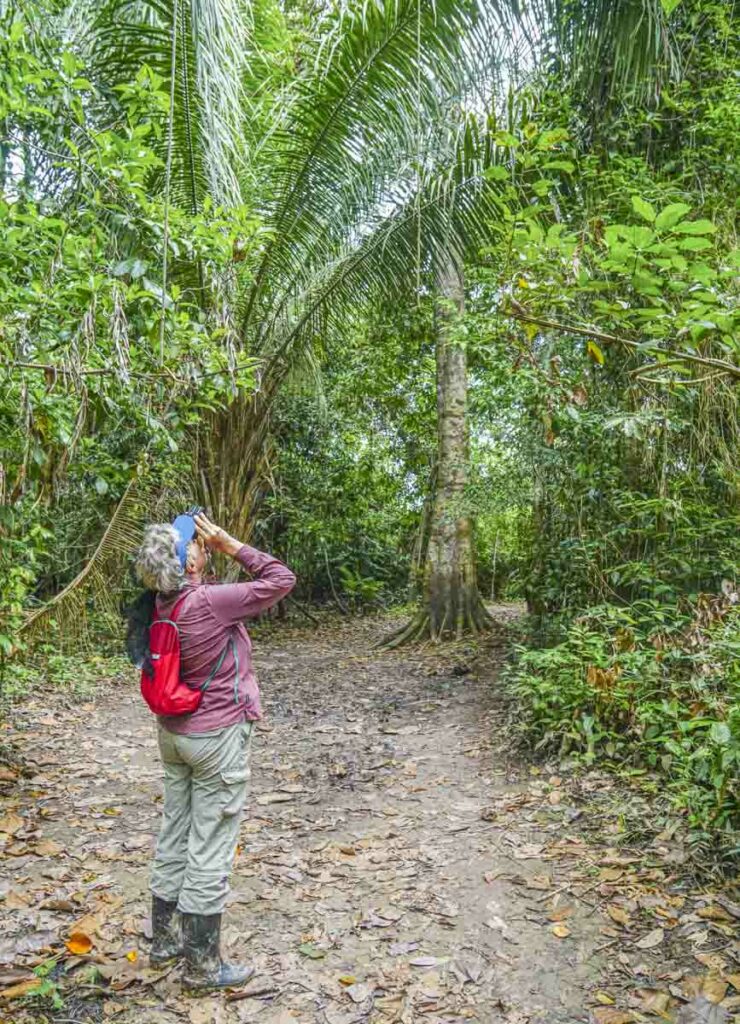
How to get to Manu National Park
The easiest way to get to Manu National Park is via bus from Cusco, followed by a boat ride up the river. This is a long journey that will take a full day.
Alternatively, you can fly from Cusco (or Lima) to Puerto Maldonado. From there, you’ll need to go by boat to access Manu National Park.
3. Reserva Nacional Tambopata
- Best from: Cusco (will need to fly into Puerto Maldonado)
- Time recommended: 2 to 3 days
Tambopata National Park forms part of the southern Peruvian Amazon. It’s located near the town of Puerto Maldonado, which is a quick flight from Cusco.
Puerto Maldonado is a small town and not as chaotic and busy as Iquitos.
Tambopata National Park is a great option for those with less time to see the jungle, as the national park is next to Puerto Maldonado. This means you won’t need to spend a whole day driving or going by boat to your jungle lodge.
You can experience a lot of the jungle here, from birdwatching to piranha fishing and more.
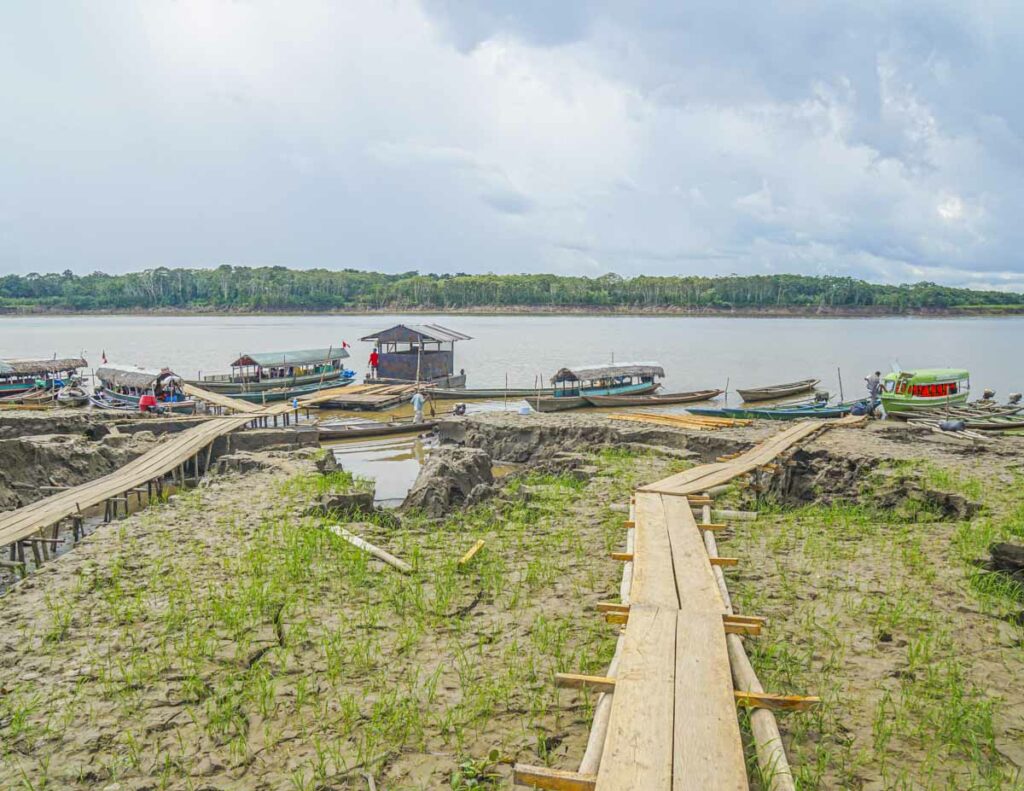
How to get to Reserva Nacional Tambopata
To get to Reserva Nacional Tambopata, you’ll need to take a 1-hour flight from Cusco to Puerto Maldonado. From here, you’ll drive or go by boat to your jungle lodge, about an hour or two away.
How to plan your Amazon tour in Peru
When planning a trip to the Amazon in Peru, you’ll need to find a tour operator or jungle lodge that will take care of your entire experience. It will be all-inclusive of accommodation, meals, transport, and activities for the duration of your stay.
This is why it’s so important to ensure you book with a reliable and ethical company.
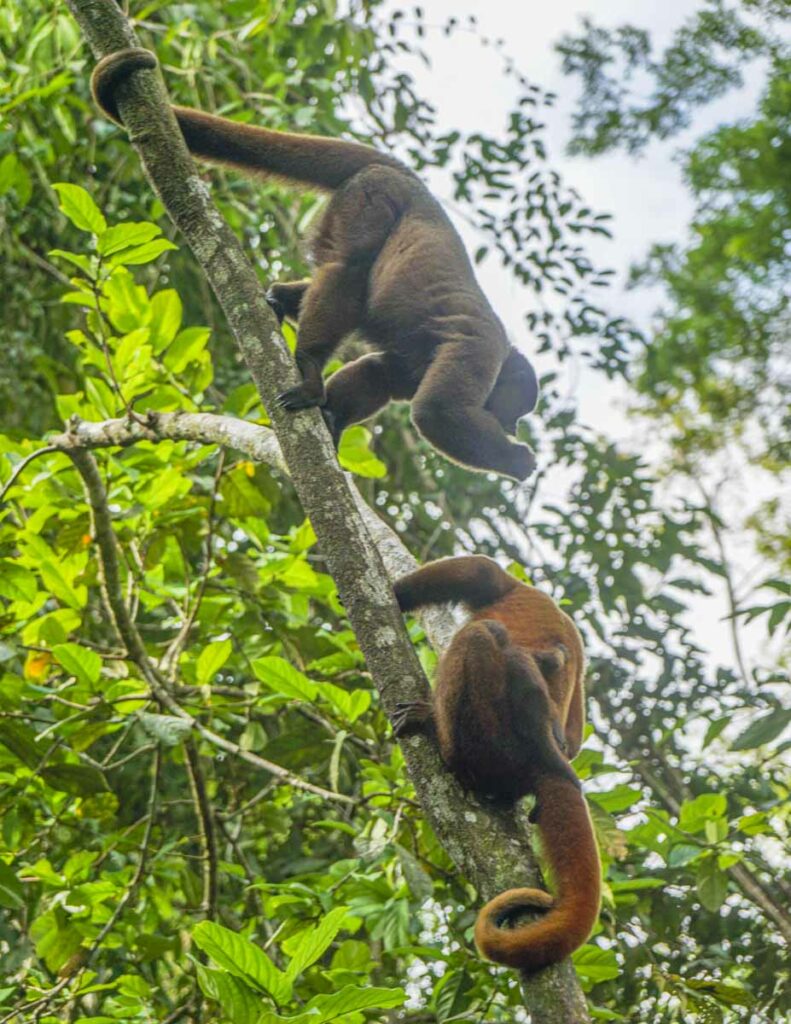
Booking an Amazon tour
I visited the Peruvian Amazon from Iquitos and booked with Libertad Jungle Lodge based on the numerous positive reviews here . They were fantastic, and I highly recommend them. No, this was not a sponsored trip, and they did not know I was a travel blogger.
Libertad Jungle Lodge is about a 4-hour journey from Iquitos and is owned and managed by the local community.
I paid 720 USD for a 4-day / 3-night tour for two people (360 USD each).
This included pick up from Iquitos, all meals (which were delicious), a basic private room with an ensuite (cold shower), and all activities. We also had a private guide who was born and raised in the Libertad Village.
The lodge itself was a rustic set-up but extremely comfortable.
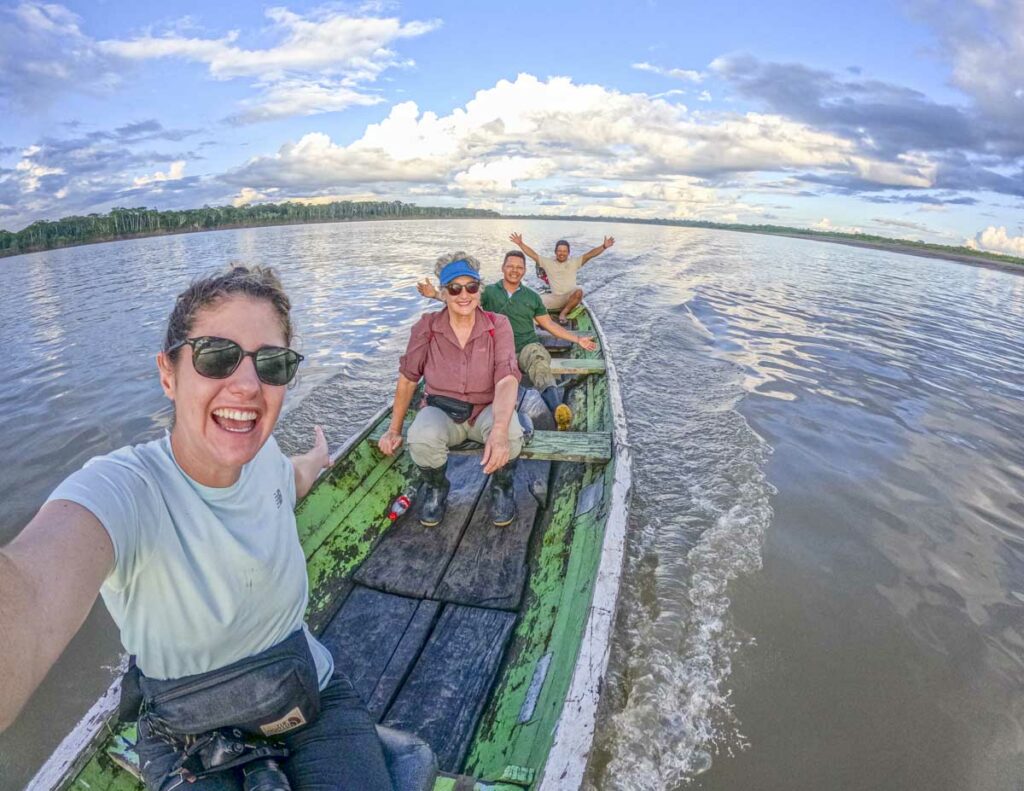
Activities on the Peru Amazon
There are various things to do in the Amazon, and your tour operator/jungle lodge will arrange them all for you.
These night walks are amazing for seeing all the creatures that come alive after dark. Tarantulas and other spiders, bats, and exotic frogs. It’s scary but it’s incredible!
I loved the boat trips along the Amazon River. You’ll go in a small wooden boat and spot birds, sloths, caimans and even pink dolphins.
Local markets
If you’re visiting the Amazon from Iquitos, I highly recommend doing a walk-through of the Belen Market. Go with your tour guide so that he can point out all the vegetables, meat, and fish. This will give you a unique perspective on how the Amazon economy works and what life is like for the local people.
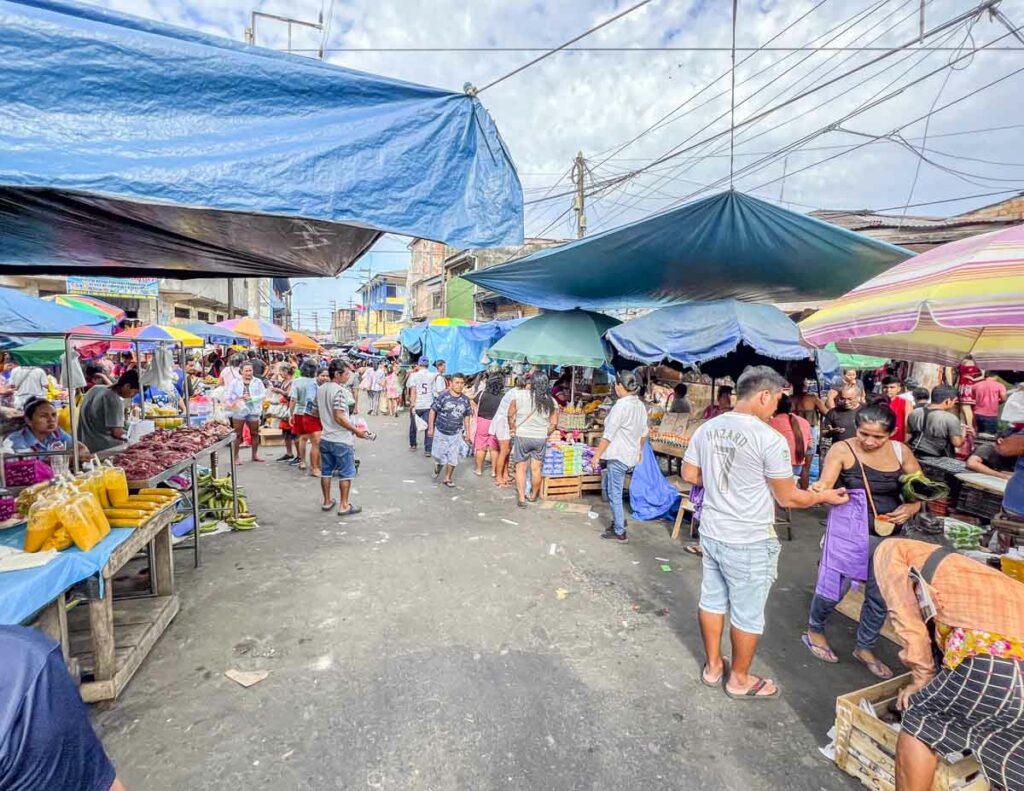
Jungle trekking
This is a part of most Amazon itineraries and allows you to go deeper into the jungle to see unique plants and trees and learn more about their medicinal value. You’ll also spot birds, spiders, mushrooms, monkeys and more.
Jungle camping
I went camping in the Amazon jungle, and wow, it was quite the experience! I recommend you do it for at least one night. Yes, it’s rough! But it’s something I’ll never forget.
Other activities
There are many other activities to do in the Amazon, including Piranha fishing, sunset trips, and canoeing.
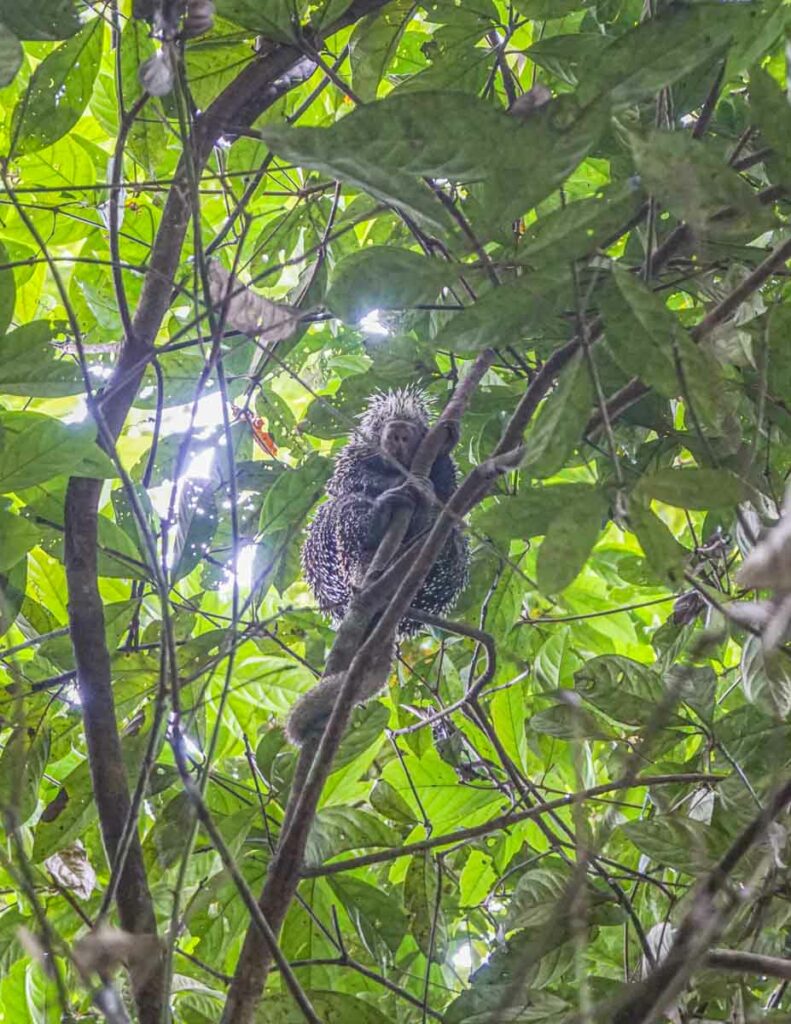
Amazon in Peru FAQs
Is the amazon in peru worth visiting.
Yes! The Peruvian Amazon is one of the best places to visit in Peru. It’s a bucket list travel destination and should be on every travel itinerary.
Does the Amazon pass through Peru?
Peru is one of the best places to see the Amazing Jungle. The Amazon River runs through the city of Iquitos in northern Peru, or you can visit the southern Amazon basin from Puerto Maldonado.
Is the Amazon in Peru dangerous?
I never felt threatened or scared when visiting the Amazon in Peru. But there are many dangerous and poisonous animals that live in the jungle, and the conditions are harsh. This is why you should book through a reputable operator who will prioritize your safety.
Like it? pin it!
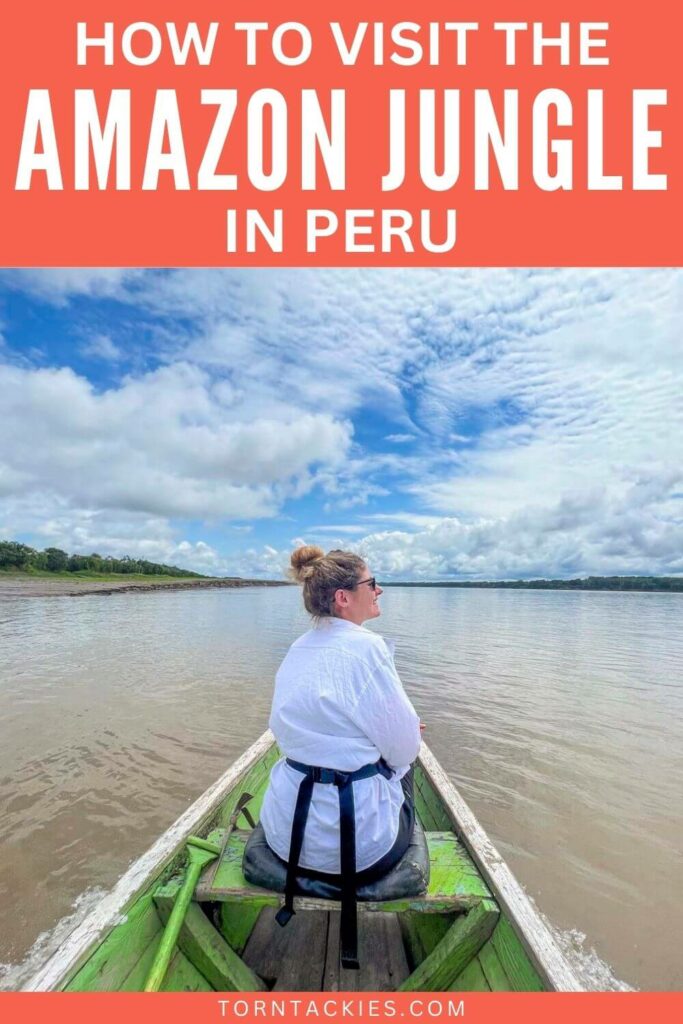
Do you have any questions about how to visit the Amazon in Peru? Or do you have any suggestions for the best Amazon tours? Drop me a message in the comments section below!
Looking for more Peru travel inspiration? Check out my other posts!
- Ultimate Guide to Salkantay Trek to Machu Picchu
- Where to Stay in Cusco Before Machu Picchu
- How to Choose Between Salkantay Trek and Inca Trail
- What to Pack For The Salkantay Trek
- How Difficult is The Salkantay Trek?
- Laguna 69 in Peru: How to Get There
- Laguna Paron: Ultimate Guide
- Hiking Guide to Laguna Llaca in Huaraz

Hi, I'm Carryn. I’m an adventure travel blogger trying to figure out my way through life by traveling and exploring. Join me as I share my travel guides and tips for life abroad. Find out more about me here .
Where to Stay in Mendoza wine country For Wine Tastings (and more)
How to hike laguna 69 in huaraz in 2024, leave a comment cancel reply.
- Destinations

Wild Junket

How to Visit the Peruvian Amazon
Last Updated on September 13, 2024
The Peruvian Amazon is one of the Earth’s wildest regions, where wildlife roam freely in unexplored jungles and flowing rivers. Based on our recent trip to Peru, here’s our guide on how to explore the Peruvian Amazon.
Dubbed the “lungs of the Earth,” the Amazon is one of the wildest and least explored parts of the world. A trip into the Amazon is like stepping into an adventure movie — one filled with mysterious creatures, and lush canopies that stretch endlessly toward the sky.
Covering about 13% of the entire Amazon, the Peruvian jungle is the most protected and purest part. The forest covers close to two-thirds of Peru but is only home to 5% of the country’s population. It’s also the only place on the planet where you’ll find 35,000 endemic species — from plants to primates — all living in harmony. In the Peruvian Amazon, you’ll meet local indigenous communities, swim with pink river dolphins, and walk beneath canopies that house flitting birds, snoozing sloths, and mischievous monkeys.
On our recent Peru trip , we took an Amazon river cruise and was absolutely blown away. Every day brought thrilling encounters: capybaras lounging on the riverbank, caimans lurking with only their eyes above water, and curious monkeys swinging overhead. In this post, I’m sharing our experience traveling the Peruvian Amazon and share with you how we planned our trip.

Table of Contents
Where is the Peruvian Amazon?
1. puerto maldonado, 2. manu national park, 3. chachapoyas, best time to visit the peruvian amazon, take a cruise on the amazon river, visit the canopy tower at tambopata research center, check out macaw clay licks, see monkeys at la isla de los monos (monkey island), take a jungle night walk, visit oxbow lakes in manu national park, visit indigenous communities in the peruvian jungle, visit the indigenous culture museum amazonicas (amazon museum), check out the floating market of belén, watch the sunrise over the jungle at tres cruces, accommodations in puerto maldonado, accommodations near manu national park, accommodations in chachapoyas, accommodations in iquitos, do you need to join a guided tour to explore the peruvian amazon, self-driving in peru, fun facts about the amazon, what to pack for your peruvian amazon adventure, enjoy your peruvian amazon adventure, how to explore the peruvian amazon.
The Peruvian Amazon is located east of the Andes, stretching to the country’s borders with Ecuador , Colombia , Brazil , and Bolivia. Covering 60% of Peru, this region has incredible biodiversity, making it one of the most biologically rich areas on Earth. As the second-largest portion of the Amazon rainforest, the Peruvian Amazon is more accessible and affordable than its Brazilian counterpart.
The jungle teems with over 35,000 species of plants, animals, and insects. For the best experience, I recommend you stay at a jungle lodge or embark on a river cruise near Iquitos. On the cruise, you’ll paddle along serene tributaries, embark on night-time insect-spotting adventures, and learn about the remarkable uses of native plants from indigenous communities. I’ll share more details below.
Where to Go and How to Get There
The Peruvian Amazon is a vast and often remote area, so we have divided it into a few popular destinations. Your choice will largely depend on your Peru itinerary and what experience you’re after. For instance, if you want to stay near Cusco, you should opt to explore the Amazon from Manu National Park or Puerto Maldonado, rather than Iquitos.
Consider what kind of experience you’re after—whether it’s adventure, wildlife spotting, or a river cruise, there’s an option to suit every style and budget. To help you better plan your vacation, here are the four most popular destinations near the Peruvian Amazon:
Found on the southern end of the Peruvian Amazon, Puerto Maldonado is a vibrant town where the Madre de Dios River weaves through lush rainforests. The region offers a front-row seat to breathtaking reserves. The Tambopata National Reserve is the most popular of the lot.
Here, you’ll find eco-lodges blending seamlessly with the jungle, providing exclusive access to the Amazon’s extraordinary biodiversity. You’ll witness macaws flocking to clay licks, serene oxbow lakes, and perhaps even catch a glimpse of a giant river otter frolicking in the water. With Bolivia just to the east and Cusco to the west, Puerto Maldonado is a perfect starting point for any Amazonian adventure. You might consider this Puerto Maldonado 4-Day Tambopata Rainforest Tour , where you’ll visit Lake Sandoval, see birds, monkeys, caimans, and more. Enjoy kayaking, with convenient pickup and drop-off at Puerto Maldonado Airport.

How to Get to Puerto Maldonado
To get to Puerto Maldonado from Cusco, you have two main options: flying or taking a bus. Flights from Cusco to Puerto Maldonado’s airport are offered once daily by Avianca, LATAM Chile, and Star Peru, with prices starting around US$190. The flight takes about 45 minutes, usually departing in the morning or early afternoon.
Cusco’s airport is 4 km from the city center and can be reached by a colectivo for about 1 sol or taxi for around 30 soles ($8). When you arrive in Puerto Maldonado, which is 4 km from the town center, take a moto taxi for 7–10 soles (around $3). Make sure to pack your Yellow Fever vaccination card, as officials sometimes request it.
Alternatively, the bus journey along the Interoceanic Highway takes about 10 hours and costs between $10 to $30, depending on the bus company and ticket class. Most buses depart from Cusco’s Terminal Terrestre, 2 km from the city center, accessible by taxi (6–8 soles) or colectivo (1 sol). Cruz Del Sur buses leave Cusco and arrive at the bus terminal in Puerto Maldonado which is just close to the city center.

Located between Puerto Maldonado and Machu Picchu , this national park is a wildlife lover’s dream where the Andes and the Amazon meet. The unique park offers a kaleidoscope of biospheres, from dense forest floors to misty mountain peaks, packed into an astonishingly compact area.
A treasure trove of wildlife viewing, bird watching, and exploring the Manu River, it’s a place that defies the imagination with its sheer diversity. The Manu National Park is divided into three zones with varying levels of access. The cultural zone is home to local communities and offers some solid wildlife spotting opportunities.
The real adventure lies in the reserved zone, where you can venture deeper into the wild. However, access to the area is somewhat limited and you must have a licensed travel agent by your side. Lastly, the core zone is the heart of Manu’s protected areas and remains off-limits to all but researchers. Consider a captivating 4-day Manu National Park Tour , where you’ll explore lush rainforests, encounter rare wildlife, and experience the beauty of the Amazon. If you don’t have 4 days, opt for this Manu National Park Tour with accommodation for a shorter, yet equally immersive experience.

How to Get to Manu National Park
To reach Manu National Park from Cusco, the best way is to fly but you can also take a bus or drive. By land, the journey starts with a 12-hour drive (280 km) along the Cusco-Paucartambo highway to the town of Atalaya. From there, you’ll continue by boat for another 12 hours on the river to reach the town of Boca Manu.
From Boca Manu, you enter the park via the Madre de Dios River. Alternatively, you can take a small plane from Cusco to Boca Manu, a 30-minute flight, and then continue the river route into the park. If you want to visit the Tres Cruces sector, known for its spectacular sunrises, depart from the district of Paucartambo to the Control Post Acjanaco. It’s a 30-minute drive followed by a 30-minute walk to the viewpoint. From there, you can enjoy a breathtaking sunrise before continuing your journey to Manu National Park.

As the capital of the Amazonas region, Chachapoyas is the gateway to northern Peru — a part of the country still flying under the radar. The charming city is the perfect base for exploring incredible attractions like the pre-Incan Kuelap ruins and the majestic Gocta Waterfall, one of the tallest.
Nearby, you’ll also find the dramatic Sonche Canyon and ancient burial sites dot the region, whispering secrets of long-forgotten civilizations. The area also exudes a jungle-like atmosphere with its humidity, lush greenery, and abundant wildlife.

How to Get to Chachapoyas
To get to Chachapoyas from Lima, you can take a flight or ride the bus. Chachapoyas has its own airport with several daily flights from Lima, making air travel a convenient choice. Aero Transporte offers daily direct flights between the cities for around $355.
For those preferring ground transport, direct buses from Lima take over 20 hours. CIVA , a well-known bus company, operates between the two cities, offering a comfortable ride for about $35 one way.

Found deep in the Peruvian jungle, Iquitos is perhaps the most popular destination in the Peruvian Amazon. Accessible only by flight, Iquitos is the easiest gateway to the mighty Amazon River in Peru and the Pacaya-Samiria National Reserve, the country’s largest natural protected area.
While here, you can explore the floating market of Belen, sail to Isla de los Monos for an up-close encounter with primates, or even swim alongside pink dolphins. The city’s architectural gems tell tales of the 20th-century rubber boom, while local museums offer deeper insight into indigenous Amazonian cultures. Consider taking this 3-day Amazon Jungle Adventure from Iquitos , where you’ll sail along the Amazon, spot dolphins, and discover the wonders of this captivating and tranquil place.

How to Get to Iquitos
To get to Iquitos from Lima, the quickest and most convenient option is to fly, as there are no roads connecting the two cities. Several airlines, including LATAM, Peruvian, and Star Perú, offer daily direct flights between Lima and Iquitos, except between 12:30 pm and 6 pm when no flights operate.
The journey takes about 1 hour and 45 minutes, making it the fastest possible way to get there. Upon arrival at Iquitos’ Coronel FAP Francisco Secada Vignetta Airport, the city center is just a 25-minute ride away by taxi or moto-taxi (a popular three-wheeled taxi).

The best time to visit the Peruvian Amazon depends on your adventure preferences. If you hate mud or want to easily spot wildlife in their natural habitat, aim for May to September. This window typically experiences lighter rainfall, making it ideal for observing animals gathering along drier riverbanks.
However, if you’re planning a river cruise in Iquitos, you’ll need to consider which season to visit and what experiences you seek. The high water season (December to May) lets boats access deeper, more remote areas of the jungle. It’s ideal for spotting canopy-dwelling birds and mammals, though it comes with heavier rainfall and more mosquitoes.
On the other hand, the low water season (June to November) offers more accessible hiking trails, fewer mosquitoes, and prime fishing opportunities. However, some remote lakes and creeks may be out of reach. Nevertheless, it’s hands down the best time to go for your Amazon River cruise .

Things to Do in the Amazon in Peru
The Peruvian Amazon has a rich biodiversity and explosive ecosystems that will make you feel like you have discovered heaven. From the outside, it feels like simply a forest walk but I promise it’s so much more. I have curated a list of possible things to do to help you plan a unique experience in one of the planet’s most beautiful rainforests;
No bucket list is complete without a cruise on the Amazon River, a journey that combines adventure with unparalleled luxury. Aqua Expeditions offers the ultimate experience in the Peruvian Amazon with two state-of-the-art vessels: the 20-suite Aqua Nera and the 16-suite Aria Amazon.
Both ships provide various itineraries suitable for solo travelers, groups, or private charters, with prices starting at over $4,000, a cost justified by the experience. On the cruise, you can partake in twice-daily excursions led by expert guides. You’ll also encounter some of the Amazon’s most elusive wildlife, including pink dolphins, spider monkeys, caiman, sloths, and anacondas.
Aboard, you can unwind in elegant suites or enjoy social spaces like the spa, plunge pool, jacuzzi, gym, or movie room. The price varies depending on when you plan to go and which suite you opt for. Please feel free to check out their early bird tickets here .

The Canopy Tower brings you closer to the wild heart of the rainforest, offering a rare vantage point high above the ancient trees. Perched 60 meters above ground, the sturdy tower provides a bird’s-eye view of the lush canopy, allowing you to spot wildlife that call this vibrant ecosystem home. Our journey began with a guided walk through the Tambopata Research Center, in the Tambopata National Reserve.
Designed by Architect Gengis Seminario, the sturdy structure ensures a safe climb, surrounded by ancient trees, bamboo patches, and scarlet macaw nests. At the top, the panoramic view unfolds, revealing the endless jungle and, on clear days, the majestic Carabaya mountains of Puno.
I recommend you plan your visit in the afternoon when the majority of the animals are taking a nap. You’ll be captivated by the sights and sounds of the rainforest but more importantly the magical energy of a sunset over one of the most breathtaking landscapes. I recommend this tour – Tambopata Peruvian Amazon Jungle for a thrilling 3-day adventure.

Seeing the Macaw Clay Licks in the Peruvian Amazon is a once-in-a-lifetime experience. The southern part of the Amazon Rainforest, accessed from Puerto Maldonado, is home to more clay licks than any other part of Amazonia. These licks, like the Chuncho and Colorado Macaw Clay Licks, attract an incredible variety of macaws from the surrounding Manu and Tambopata regions.
From the Tambopata Research Center, you can access one of the largest clay licks, the Colorado Macaw Clay Lick. It is a base for researchers studying macaw behavior. While here, you’ll be greeted by a spectacular display of color and sound as macaws flock to detoxify from forest foods.
At the Chuncho Clay Lick, about two hours from Refugio Amazonas, you are treated to one of the highest concentrations of macaws in the world. While the activity of these majestic birds varies with the season and weather, witnessing the macaws in their natural habitat is an unforgettable experience. Book this 2-day tour of Tambopata National Reserve to observe the vibrant macaw clay lick and immerse yourself in the stunning Amazon landscape.

Monkey Island is a 450-hectare sanctuary and rescue center dedicated to the rehabilitation and protection of monkeys. While here, you’ll witness more than seven species of monkeys in their natural habitat and learn about the care provided to help them grow strong and healthy.
It’s located 30 km from Iquitos in the Amazon jungle of Peru and is best reached by boat. The journey begins with a fast boat ride from Puerto de Productores, followed by a 20-minute walk through the Amazon jungle. A return ticket to the island costs around 55 Soles ($15) and the entrance fee to the sanctuary is about 50 soles ($13).

Venture into the nocturnal world of the Amazon on a jungle night walk and discover a side of the rainforest that’s both eerie and exhilarating. With only the glow of your head torch lighting the way, you’ll embark on a 1-hour hike that feels like stepping into another realm. At first, you might feel a twinge of hesitation, but that quickly fades as the jungle comes alive with its night-time wonders.
As the usual daytime creatures rest, a weird and wonderful mix of wildlife emerges. You’ll see tarantulas peeking out from their nests, slimy frogs clinging to leaves, slithering snakes weaving through the underbrush, and the mischievous calls of night monkeys.
It’s an experience like no other, offering a rare glimpse into the Amazon’s mysterious after-dark ecosystem. On my trip, I joined this 2-day and 1-night tour in Iquitos and it was an excellent experience.

A visit to the oxbow lakes of Manu National Park is a unique experience and one you cannot afford to miss. Accessible by boat, these serene lakes offer a unique vantage point through an enchanting landscape. Surrounded by the jungle, the lakes are a habitat for a rich variety of wildlife, including monkeys, birds, and other animals.
The oxbow lakes were formed over centuries as bends in the river were gradually cut off from the main flow. The Manu River has created several oxbow lakes over the centuries but Lake Salvador and Lake Otorongo are the most popular ones.
For the best experience, start your day early and glide across the tranquil waters in a paddle-driven boat. With a bit of luck, you might spot caimans, several bird species, and even giant otters.

In Manu, you can meet indigenous groups who have lived the way their ancestors have lived for centuries, providing a profound understanding of their deep-rooted connection to nature. By learning about their traditions, natural medicine, and conservation practices, you will gain unique insights into life in the Amazon.
It is also a great way to contribute to responsible tourism enabling you to support these communities directly. You can do this by purchasing local crafts and participating in cultural activities that honor their way of life.

To better understand Peruvian indigenous communities, make a trip to the famous Amazon Museum in Iquitos . It is a captivating journey into the heart of culture in the Amazon Basin. The museum’s mission is to preserve and showcase the vibrant cultural tapestry of the Peruvian Amazon’s indigenous communities.
As you wander through the museum, you’ll encounter several exhibits representing around 40 distinct Amazonian cultures. Each display is thoughtfully curated to highlight the diverse heritage and rich customs of the tribes that call the Amazon home. While here, you’ll gain a deep understanding of their unique ways of life and the profound connection they keep with their environment.

At the southeast end of Iquitos lies the Floating Market of Belén, an intriguing shantytown composed of numerous huts built on rafts. During the dry season, these rafts rest on river mud, but for most of the year, they float amidst the vibrant chaos of the river.
Home to around 7,000 residents, Belén Market offers insight into the community’s daily life, with canoes drifting between huts to sell and trade jungle produce. But be prepared for a sensory overload, as the market features sights and smells that can be quite intense, including butchered turtles and caiman reproductive organs.
As with most markets, the floating market of Belén is best explored in the morning for the full experience. For safety, don’t carry any valuables, stay vigilant in crowded areas, and respect local customs, including asking for permission before taking any photos. Consider joining this Belen Market tour with a local guide.

Watching the sunrise over the Amazon at Tres Cruces is an unforgettable experience you can’t afford to miss when visiting Manu National Park. Located about two hours beyond the city of Paucartambo, Tres Cruces offers one of the most breathtaking viewpoints in the Central Amazon. As dawn breaks, the mountains seem to dissolve into the vast rainforest below, revealing a stunning panorama that is nothing short of spectacular.
The ethereal blend of colors as the sun rises over the mist-shrouded jungle is mesmerizing and a great way to start your Amazon adventure. For a truly unforgettable adventure, arrange your journey to this extraordinary spot with a taxi company in Paucartambo.

Where to Stay in the Peruvian Amazon
From rustic lodges to high-end eco-retreats, most of the destinations near the Amazon offer a range of accommodations that cater to different tastes. Here are the best accommodations within and around the Peruvian Jungle;
Eco Amazonia Lodge
Staying at Eco Amazonia Lodge is a unique and immersive experience. Nestled along the banks of the Tambopata River within the Tambopata Reserve, the lodge features 50 eco-friendly cabins constructed with local materials. While here, you are virtually guaranteed sightings of remarkable wildlife, including giant otters and elusive alligators. Check out the rates here .
Kapievi Ecovillage
This locally-run, family-operated ecovillage provides cozy cabin accommodations, each featuring one or two single beds and an outdoor bathroom with sweeping views of the lush rainforest. The hotel also arranges health-related and spiritual activities like yoga and meditation in the purpose-built maloka—a serene, open, circular cabin at the village’s core. Check out the rates here .

Manu Backpackers Camp
Staying here offers a unique and convenient base for exploring Manu National Park and the Amarakaeri Indigenous Reserve. The camp offers a spectacular view of the Salvacion River, with private stairs leading directly to its crystal-clear waters, perfect for a refreshing swim. Tents are comfortably set up on wooden platforms, each equipped with mosquito nets, mattresses, and cozy seating with pillows. Check out rates here .
ZYGO Bed & Breakfast
Located in Tarapoto, ZYGO is a charming boutique stay near the vibrant Peruvian Jungle, combining modern amenities with a touch of nature. While here, you can unwind in the lush garden or relax on the terrace, all while staying connected with free WiFi. The rooms feature fully equipped private bathrooms with showers and complimentary toiletries. Check out the rates here .
Canto del Río Lodge
Found in the serene valley of the Cumbaza River and facing the majestic Cordillera Escalera mountains, this hotel is a touch of luxury and modern comforts. The lodge features nine bungalow-style rooms, thoughtfully designed to blend harmoniously with their natural surroundings, providing guests with an immersive jungle experience. Check out the rates here .

Ceiba Tops Luxury Lodge
Found within the Amazon, this lodge offers a blend of comfort and adventure, making it ideal for those seeking a touch of luxury amidst the wild. The lodge features 72 secluded rooms scattered among lush tropical gardens. Check out the rates here .
Explorama River Lodge
Located just 80 km from Iquitos, Explorama River Lodge offers an authentic yet comfortable Amazonian escape. The lodge’s 55 traditionally designed guestrooms feature private bathrooms and beds equipped with mosquito nets. A unique highlight of the property is the “Hammock House,” a serene spot perfect for unwinding as the soothing sounds of the rainforest envelop you. Check out the rates here .

Technically you can absolutely go to the Peruvian Amazon on your own, but we highly recommend booking a tour to venture further and experience all that the rainforest has to offer. Most tour operators offer packages that include transportation, meals, and accommodation. A major advantage of guided tours is having a wildlife guide who can expertly spot elusive animals like pink dolphins.
On our trip to the Peruvian Amazon, we opted for a 3-nights tour on the Aqua Nera and we were very happy to choose them for our river cruise. It felt like we were on an adventure, and yet in between excursions, we could return to the comfort of our suites. The food, amenities and service were all topnotch and I cannot recommend them enough.

Self-driving offers an adventurous way to explore Peru’s diverse landscapes, from the towering Andes to the lush Amazon rainforest. However, it comes with challenges that require a confident and prepared approach. Roads can vary drastically in quality across the country.
You’ll find well-maintained highways connecting major cities like Lima , Cusco , and Arequipa, while rural routes are typically rugged, narrow, or unpaved. We rented a car in Lima and Cusco , and found driving in Peru rather easy and straightforward. The main hazard to watch out for are the crazy drivers. We also had the misfortune of encountering a corrupt cop who asked for a bribe as we didn’t have our lights on (during the day!).
Search for car rentals in Cusco here!
We didn’t rent a car in the Peruvian Amazon, as we’ve heard how bad the roads can get. When renting a car for destinations near the Amazon, a 4×4 is not a necessity, but a vehicle with high ground clearance is advisable. Recommended models include the VW Gol, Renault Duster, Kia Grand Carnival, and Toyota RAV4. For car rentals, we always use DiscoverCars , as they consistently offer the best rates and customer service, with rentals typically costing around $58 per day.
Search for car rentals in Lima here!

- Over half of Peru is covered by lush jungles and rainforests, with the Amazon Rainforest being the largest. Peru is part of the Amazonas, a group of four countries through which the Amazon River flows.
- The Amazon River Basin in northeastern Peru is the largest rainforest on Earth.
- The Amazon is home to a staggering variety of bird species, representing at least one-third of the world’s total, with the toucan being the most popular.
- More than half of the world’s estimated 10 million species of plants, animals, and insects are found in tropical forests like the Amazon.
- About 90% of rainforest plants used by Amazonian tribes have not yet been studied by modern scientists.
- There are an estimated 250,000 indigenous people in the Amazon, comprising 215 ethnic groups speaking around 170 different languages. Also, there may be about fifty uncontacted tribes living deep within the Amazon rainforest, isolated from the outside world.

- Spanish phrase book – It’s best to learn some basic Spanish: “ holá” (hello), “ Buenos días ” (good morning), “ por favor ” (please), “ gracias ” (thank you). If your Spanish isn’t great, download the Spanish dictionary on Google translate before setting for your trip. And get this Spanish phrase book.
- Insect repellent – Although in the dry season, there are fewer biting insects that doesn’t mean that there are none at all. Make sure to pack some strong insect repellent with a high level of deet .
- SPF 50+ sun cream – You will be spending some long hours out on the river and there’s a good chance you will not have any shade. Get this sunscreen lotion.
- Sun hat – Whilst spending many hours on the river it is important to protect your head. It’s easy to get sunstroke if you don’t wear adequate sun protection. Consider a hat like this.
- LifeStraw – Not all lodges offer free drinking water in Peru. We absolutely swear by our LifeStraw Go filter water bottle ! Not only does it reduce plastic waste, it will save plenty of money on the road as you can drink the tap water (or any other water for that matter) even in places where it isn’t advised.
- Long sleeve, lightweight t-shirt – If you are fair-skinned and burn easily it’s a good idea to wear long sleeves on your days getting around the towns or on the river cruise.
- Lightweight hiking pants – We opted for zip-off hiking trousers rather than traditional safari attire to give us the option to expose our legs for periods of time to cool down.
- Camera – If you don’t already have a camera you love, have a look into the Canon EOS r5 – r7 range. They are pricey but they have an animal eye autofocus which makes pictures amazing.
- Binoculars – Binoculars are a great help for spotting animals. We use the Steiner Navigator Pro and swear by it! It’s not cheap but well worth the investment if you love wildlife travel .
- Torch – If you can take a high-powered torch , it will be invaluable on the night jungle walk.

Thank you for reading this far. I hope this guide has helped you plan how to explore the Peruvian Amazon. If you have any questions on the Peruvian Amazon, please leave them in the comments below and I will be happy to reply to any questions you have. Please read my other articles about Peru and the Amazon below;
- My 10-Day Peru Itinerary
- Cool Things to Do in Lima
- Visiting Peru with Kids
- Cool Things to Do in Cusco
- Guide to Sacred Valley, Peru
- How to Get to Machu Picchu
- How to Visit Ecuador’s Amazon
- Fun Things to Do in Bogota, Colombia
- My Guide to 2 Weeks in Brazil
Disclaimer: This post contains affiliate links i.e. if you book a stay through one of my links, I get a small commission at NO EXTRA COST to you. Thank you for your support!
Inspired? Pin it!

Nellie Huang
Nellie Huang is the founder of WildJunket. Originally from Singapore, Nellie has traveled to over 150 countries across 7 continents. As an accomplished travel writer, she has written for BBC Travel, CNN and Rough Guides . She is also the author of five travel books, including the latest Lonely Planet's Mexico guidebook. Read more about her here and follow her on Facebook and Instagram .
Leave a Comment Cancel Comment
Save my name, email, and website in this browser for the next time I comment.
This site uses Akismet to reduce spam. Learn how your comment data is processed .
The Comments
Good overall description of all the options. However, the photo shown after the description of the Canopy Tower at Tambopata appears to be one of the Canopy Walkway at Explorama. There is no walkway at Tambopata.
Thanks for pointing that out! We didn’t have a photo of Tambopata so we used that image. How did you like Explorama?
You May Also Like
13 things to do in georgetown, guyana, 23 cool things to do in trinidad and tobago, bergen travel guide: norway’s fjord capital.

Ultimate Guide to Visiting the Amazon in Peru: Iquitos, Manu National Park & Puerto Maldonado
Embarking on the adventure of a lifetime begins with the promise of immersing yourself in the awe-inspiring wonders of nature. Visiting the Amazon in Peru is not just a journey; it’s a rendezvous with the heart of the world’s largest rainforest, an ecosystem teeming with unparalleled biodiversity. In this comprehensive guide, we unveil the secrets of three exceptional destinations— Iquitos, Manu National Park, and Puerto Maldonado— each offering a distinct tapestry of experiences in the Peruvian Amazon. From the vibrant rhythms of Iquitos to the pristine wilderness of Manu and the gateway to the extraordinary Tambopata Reserve in Puerto Maldonado, prepare to unlock the mysteries of this mesmerising realm. This is your ultimate passport to the untamed beauty of visiting the Amazon in Peru.
This article contains affiliate links from the Amazon Associate and Travelpayouts programs. Wild Travel Tales will earn from qualifying purchases, at no extra cost to you .
The Peruvian Amazon: A Breathtaking Tapestry of Diversity
The vastness of the Peruvian Amazon, covering 7,000,000 km², with 5,500,000 km² as pristine rainforest, makes it a jewel in South America’s crown. A staggering 13% of this ecological wonder belongs to Peru, ranking second only to Brazil. Despite this vast expanse, a mere 5% of Peru’s population calls the Amazon home, underscoring the untamed nature of this jungle paradise.
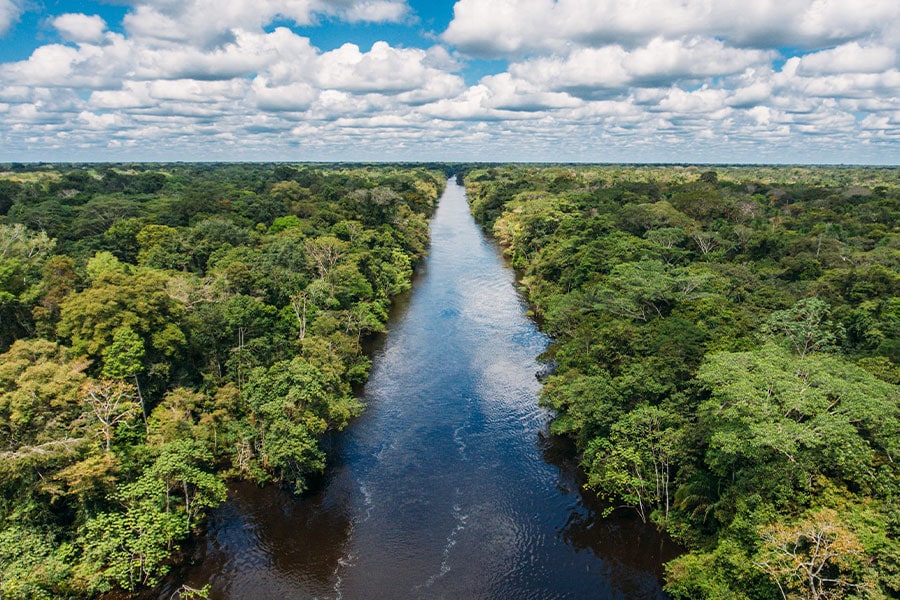
Navigating the Amazonian Tapestry: A Guide to Your Expedition
Where to go & how to get there.
Selecting the perfect destination in the Peruvian Amazon requires strategic planning. Whether you choose the verdant landscapes of Pacaya Samiria, the cultural richness of Chachapoyas, the vibrant cityscape of Iquitos, or the accessibility of Central Selva, each promises an immersive experience. Travel logistics play a crucial role, and we guide you on how to navigate the rivers, roads, and airways to reach your chosen haven.
The Peruvian Amazon caters to both adventure enthusiasts and luxury travelers, offering a wide range of destinations with suitable infrastructure. Ensuring a seamless match with your budget and travel preferences is easily achievable. As you plan your journey, it’s valuable to note that the term “selva,” meaning jungle, is commonly employed in the region.
Carefully curated, our selection includes popular destinations where travelers commonly embark on their jungle adventures. While accessibility and locations may vary, the allure of the Peruvian Amazon lies in the consistent wonders of its flora and fauna, creating a truly magnificent experience across the board.
Visiting the Amazon from Iquitos
As the world’s largest city inaccessible by road, Iquitos stands as a unique gateway to the Amazon. Nestled along the banks of the Amazon River, this vibrant city offers a distinctive starting point for your Amazonian adventure. Visiting the Amazon from Iquitos is the best way to fully immerse yourself in the jungle.
Explore the bustling markets, immerse yourself in local culture, and embark on river journeys that unveil the rich biodiversity of the Peruvian Amazon. This is the perfect way to get deeper into the Amazon, particularly if you spend more than two days immersed in the jungle. Iquitos is only accessible via boat or air. You can get affordable flights to Iquitos airport from Lima.
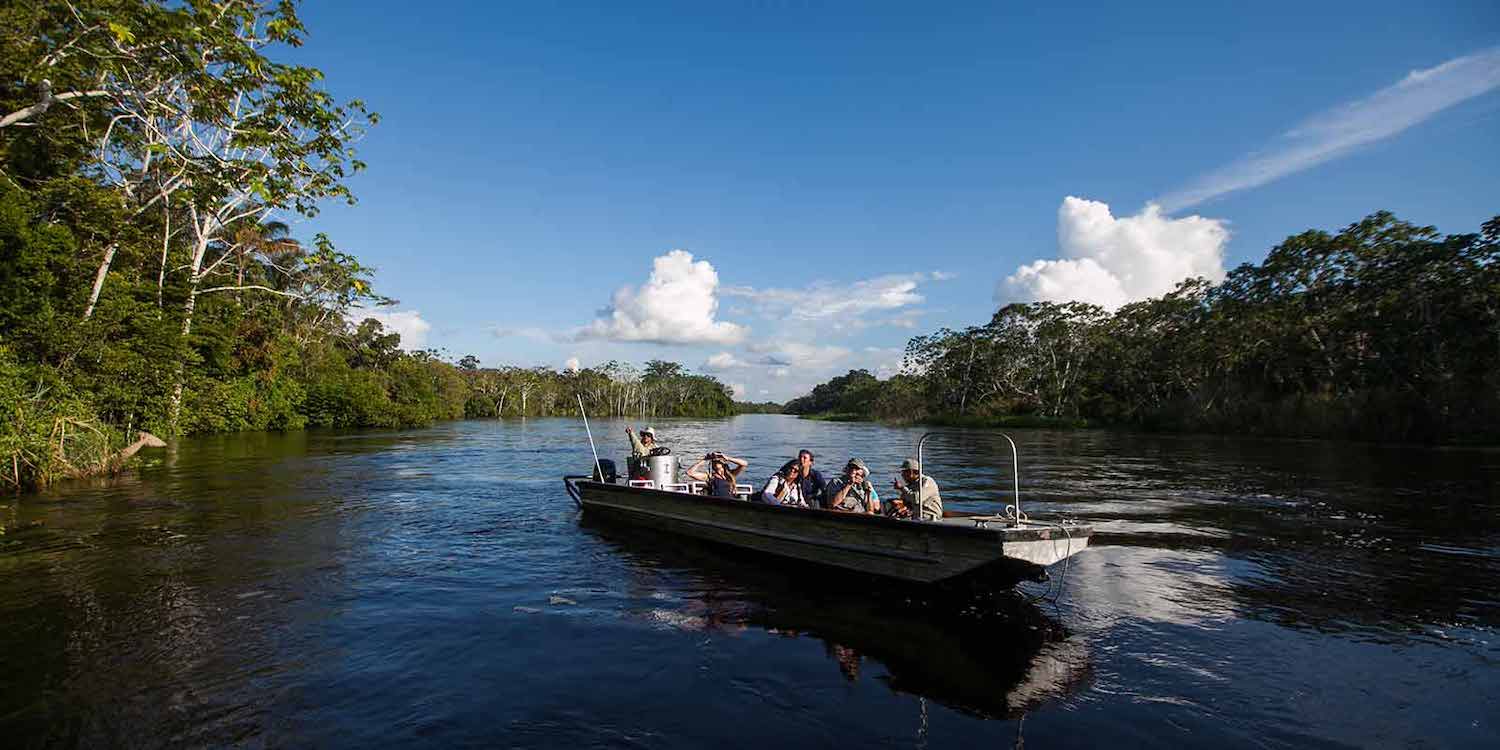
Chachapoyas
Northern Peru often escapes the radar of international travelers, yet, in our perspective, it boasts a plethora of attractions, including the pre-Incan Kuelap ruins, the majestic Gocta Waterfall, the stunning Sonche canyon, and numerous burial sites.
Serving as the gateway to this region is Chachapoyas, a city frequently regarded as perched on the edge of the Amazonas region. While the humidity and abundant flora and fauna provide a jungle-like ambiance, those seeking a more immersive experience may opt to venture further inland, embarking on a day-long journey to the town of Tarapoto—an intriguing option.
Central Selva
Exploring the jungle in central Peru brings the advantage of excellent connectivity from the capital city, Lima. Though the journey may still be challenging, improved roads and remarkable wildlife, especially for birdwatching enthusiasts, make it a worthwhile venture.
Consider the Chanchamayo Province for your adventure, which, in our view, resembles an average cloud forest akin to those seen in Mindo, Ecuador. Alternatively, expand your itinerary to include Oxapampa, Pozuzo, or Pucallpa.
Manu National Park: UNESCO’s Crown Jewel
Explore the wonders of Manu National Park, a UNESCO World Heritage site, conveniently accessed from Cusco. Dive into the diverse ecosystems, each revealing a unique facet of the Amazon’s biodiversity. Navigate through the park’s zones, from the cultural to the reserved, for an unparalleled encounter with nature.
While the cultural zone, where local communities reside, offers high chances of wildlife spotting, we recommend the reserved zone for a deeper exploration. Note that not all travel agents have permission to access the reserved zone, underscoring the importance of a wise choice.
Puerto Maldonado: Gateway to Tambopata’s Riches
Puerto Maldonado beckons with its diverse offerings, accessible by air or an adventurous bus journey. Discover the famed Reserva Nacional Tambopata and unveil the treasures it holds. We provide insights into budget-friendly accommodations like Hostal Tropical Inn and opulent retreats like Hotel Enai.
Is it Worth Visiting the Amazon in Peru?
Embarking on a journey to the Amazon in Peru is a decision that promises an unparalleled adventure, but is it truly worth the trek into this vast and diverse region? The resounding answer is a definitive yes. The Peruvian Amazon, encompassing approximately 60% of the entire country, beckons with its awe-inspiring natural wonders and cultural richness.
Unique Biodiversity: One of the primary reasons to venture into the Peruvian Amazon is its unparalleled biodiversity. Home to almost 1900 bird species, about 500 mammal species, and a myriad of other flora and fauna, this region stands as a paradise for nature lovers. From iconic pink dolphins to elusive jaguars, the Amazon unfolds a captivating tapestry of wildlife that is sure to leave you in awe.
Cultural Enrichment: Beyond its biological diversity, the Peruvian Amazon offers a unique cultural experience. Indigenous communities call this rainforest home, and a visit provides an opportunity to engage with their traditional way of life. From learning about medicinal plants to experiencing indigenous rituals, the cultural aspect of the Amazon adds a layer of depth to your journey.
Adventurous Activities: For those seeking an adrenaline rush, the Amazon doesn’t disappoint. From challenging jungle walks and night canoeing under the starlit sky to venturing into remote areas, the adventurous activities in the Peruvian Amazon cater to various tastes. Whether you choose to explore on foot or navigate its intricate waterways, the Amazon presents a playground for intrepid explorers.
Environmental Significance: Often referred to as the “Lungs of the World,” the Amazon rainforest plays a crucial role in maintaining the planet’s ecological balance. Visiting this natural wonder allows you to witness firsthand the environmental significance of preserving this ecosystem. It instills a sense of responsibility for the conservation of the Amazon’s unique and fragile environment.
Unforgettable Experiences: While the journey may not be the most budget-friendly, the experiences garnered from a trip to the Amazon are priceless. Be it camping in the heart of the rainforest, encountering wildlife in its natural habitat, or connecting with local communities, the memories forged in the Amazon become indelible imprints on your travel chronicles.
In conclusion, the Peruvian Amazon is not merely a destination; it’s an immersive journey that offers a transformative travel experience. Whether you’re a nature enthusiast, cultural aficionado, or adventure seeker, the Amazon in Peru beckons with open arms, promising a sojourn that transcends the ordinary and leaves an indelible mark on your wanderlust-filled soul.
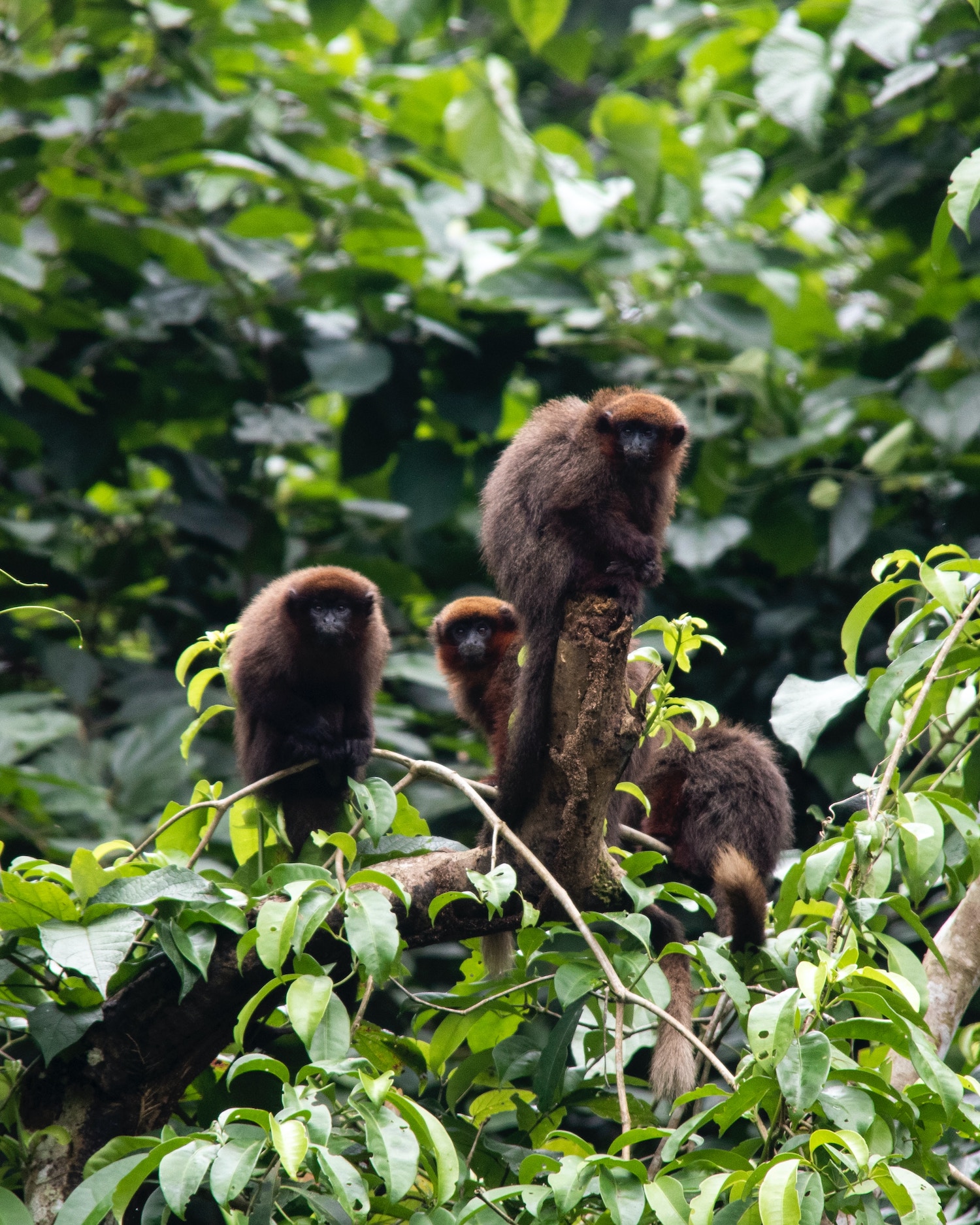
When Is the Best Time to Visit the Amazon?
The Peruvian Amazon is a captivating destination that offers a unique experience year-round, but choosing the best time to visit can enhance your adventure. The region has two distinct seasons: the dry season from May to October and the rainy season from November to April. While both seasons showcase the breathtaking beauty of the Amazon, each offers a slightly different experience.
During the dry season, from May to October, the weather is relatively stable, with lower chances of rain, making it an ideal time for hiking and exploring the jungle trails. On the other hand, the rainy season, from November to April, transforms the landscape into a lush, vibrant haven. Although rainforest excursions may be more challenging, this season presents an opportunity to witness the Amazon in its full splendor, with swollen rivers and a burst of greenery.
Wildlife enthusiasts may find the rainy season particularly rewarding, as the increased water levels facilitate boat excursions, offering a unique perspective on the flourishing ecosystem. Ultimately, the best time to visit depends on your preferences and the type of experience you seek, whether it be the dry season’s accessibility or the rainy season’s lush, vibrant ambiance.
Wildlife in the Peruvian Amazon
Delve into the mesmerizing world of the Peruvian Amazon’s wildlife. With nearly 1900 bird species and 500 mammal species, the region unfolds as a paradise for nature enthusiasts. From pink dolphins to elusive jaguars, our narrative paints a vivid picture of the Amazon’s diverse inhabitants.
As you traverse this ecological marvel, be prepared to encounter a rich tapestry of wildlife that calls this region home. Here’s a glimpse into the diverse fauna that awaits you:
- Birds: With almost 1900 bird species, the Amazon is a paradise for bird watchers. Look out for vibrant macaws, toucans, hoatzins, and the iconic camungo.
- Mammals: From elusive jaguars and playful river otters to howler monkeys and capuchins, the Amazon shelters around 500 mammal species.
- Aquatic Life: The Amazon River teems with diverse aquatic life, including pink dolphins, piranhas, caimans, and the elusive black armor fish.
- Insects and Invertebrates: The rainforest floor is a microcosm of life, featuring an array of colorful butterflies, spiders, and insects, some with remarkable medicinal properties.
Each region of the Peruvian Amazon offers unique opportunities to witness specific wildlife:
- Manu National Park: Ideal for a deeper wildlife experience, Manu’s reserved zone provides opportunities to spot elusive species. Be explicit about your preferences when booking a tour.
- Iquitos & Pacaya Samiria National Reserve: Known for its biodiversity, especially during longer expeditions, this reserve near Iquitos offers encounters with diverse flora and fauna.
- Puerto Maldonado: The gateway to the Tambopata National Reserve, this region is famed for its diverse bird species, including toucans and parrots.
- Chachapoyas and Central Selva: Northern regions boast attractions like the Gocta Waterfall and diverse cloud forests. The Central Selva, well-connected from Lima, is excellent for birdwatching, including spotting rare species.
In essence, the Peruvian Amazon is a living, breathing spectacle of nature. The choice of your expedition destination can shape the array of wildlife encounters you’ll experience. Whether it’s the lush jungles of Manu, the aquatic wonders of Pacaya Samiria, or the diverse birdlife in Central Selva, each region unfolds a unique chapter in the captivating narrative of the Amazon’s wildlife.
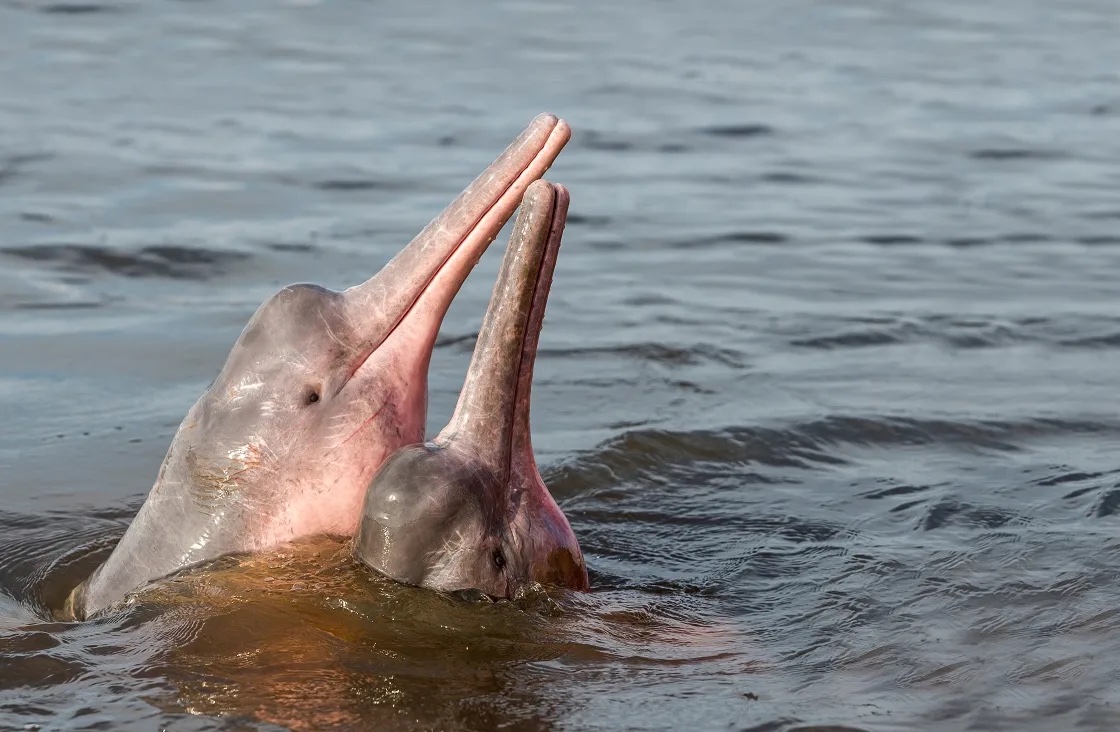
Activities to Do When Visiting the Amazon in Peru
Embarking on an adventure in the Peruvian Amazon is not just a journey. It’s an immersive experience into the heart of one of the world’s most diverse ecosystems. As you delve into this lush paradise, a myriad of activities awaits, promising encounters with unique wildlife and a deep connection with the rainforest. Here are some must-try activities to make your Amazon expedition truly unforgettable:
Jungle Walks
Explore the heart of the Amazon on foot with guided jungle walks. Traverse well-maintained trails or venture into more challenging terrains. You will experiencing the tranquility of the rainforest while keeping an eye out for diverse flora and fauna. The deeper you go, the more enchanting the wildlife encounters become.
Night Canoeing
Embark on a nocturnal adventure with night canoeing. As darkness envelops the river, navigate through the Amazon waters under the stars. The immersive experience allows you to connect with the environment in a unique way. You will be surrounded by the mysterious sounds of the jungle and the glittering night sky.
Indigenous Village Visits
Engage in cultural exchanges by visiting indigenous villages scattered throughout the Amazon. Accompanied by your guide, you can:
- Experience the authenticity of local communities
- Partake in traditional activities
- Gain insights into their way of life
The vibrant celebrations and warm hospitality make these visits truly memorable.
Fishing Excursions
Try your hand at fishing in the Amazon’s pristine waters. Whether you’re releasing fish back into the river or aiming for the catch of the day, fishing excursions provide a hands-on experience with the aquatic life of the Amazon. It’s a peaceful yet exciting way to connect with the natural rhythms of the river.
Wildlife Spotting
The Amazon is renowned for its diverse wildlife. Take part in wildlife spotting activities, especially during the early morning, late afternoon, or night. From rare bird species and playful monkeys to the iconic pink dolphins, each wildlife encounter adds a layer of fascination to your Amazon journey.
Nature Walks
Beyond the dense vegetation, pay attention to the unique plants and trees. Guided nature walks not only showcase the fascinating flora but also introduce the medicinal uses of various plants. Your guide’s stories about traditional remedies and the rainforest’s healing properties add depth to your nature exploration.
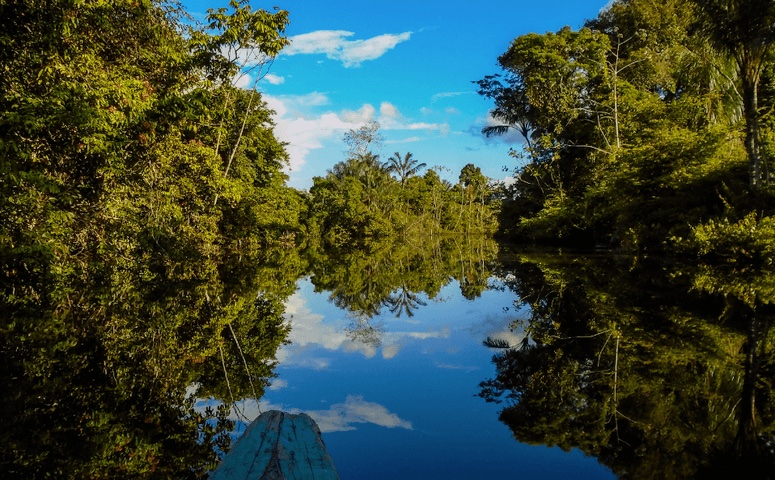
Packing Essentials When Visiting the Amazon in Peru
Equip yourself for the Amazonian challenges with our detailed packing list . Tailored to your chosen mode of exploration, whether lodge or tent, our comprehensive guide ensures you have the essentials for a comfortable and memorable journey.
Embarking on a journey to the Peruvian Amazon is an adventure unlike any other, but venturing into this lush and diverse ecosystem requires careful preparation. From protection against insects and the elements to staying hydrated and capturing unforgettable moments, here are 10 key essentials you simply can’t explore the Amazon without:
- Lightweight, quick-drying clothing : Long-sleeve shirts, lightweight pants, and shorts made of moisture-wicking materials. Light colours are preferable to deter mosquitoes.
- Jungle strength insect repellent : A strong insect repellent containing DEET or picaridin to protect against mosquitoes, sandflies, and other insects.
- Wide brimmed hat : A high-quality hat is essential to protect against the intense Amazonian sun. Pair with a high SPF sunscreen (preferably eco-friendly) and good pair of sunglasses !
- Sturdy outdoor hiking boots : Sturdy, waterproof hiking shoes or boots with good traction to navigate through muddy trails and protect against insect bites.
- Lightweight, breathable rain jacket : A lightweight, waterproof jacket and pants to stay dry during frequent rain showers in the Amazon rainforest.
- Binoculars : Quality binoculars to observe wildlife up close, as many animals in the Amazon are high in the canopy. It might seem like extra weight and space in your pack, but it’s worth it!
- Water purification tablets : A refillable water bottle and water purification tablets to ensure access to safe drinking water.
- Headlamp : A reliable flashlight or headlamp for nighttime jungle treks and power outages. Most lodges have unreliable electricity, often turned off in the evenings. You’ll be grateful to have a good headlamp!
- First aid kit : A basic first aid kit including bandages, antiseptic wipes, pain relievers, diarrhoea medication, and any prescription medications you may need.
- Waterproof pouch for your smartphone : Capture your Amazon adventure with a waterproof camera or a protective case for your smartphone or camera to guard against rain and humidity.
Embark on your Amazonian expedition with this comprehensive guide, where every paragraph unfolds a new chapter in your journey. Discover the Peruvian Amazon’s wonders, from the depths of Pacaya Samiria to the cultural richness of Chachapoyas, the vibrant cityscape of Iquitos, and let the adventure begin!
The Peruvian Amazon can be visited year-round, but understanding the distinct dry and rainy seasons aids in planning. The dry season from May to October offers different wildlife experiences compared to the rainy season from November to April.
The Peruvian Amazon boasts a rich tapestry of wildlife, including pink dolphins, various monkey species, jaguars, and a myriad of bird species. However, wildlife spotting is nature-dependent, and sightings are not guaranteed.
Planning your Amazonian adventure on a budget is feasible. Opt for local travel agencies, consider bus travel, and explore budget-friendly accommodations. Flexibility in your schedule allows for on-the-spot tour arrangements, often at lower costs.

Lucas is a travel writer with deep experience exploring South America. He enjoys hiking through mountain ranges, cycling across deserts and paddling down rivers.
Peruvian Amazon: How to Visit the Amazon from Iquitos, Peru
Best travel sim cards for international mobile data in 2024, get our best tips direct to your inbox.

IMAGES
VIDEO
COMMENTS
With its distinctive geography and captivating flora and fauna, the Amazon Jungle in Peru offers some incredible places to visit and activities to engage in. Here are some of the best ways to explore and appreciate this region and its wonders.
Amazon in Peru is a vast and diverse region, and planning the trip is challenging. We've put together this travel guide on the Peruvian Amazon, including things to know, how to get, when to visit, which area to choose, what to pack, and what to expect.
Here's the ultimate guide to the Amazon in Peru. It includes where to go, how to get there and the best tours for the Amazon Rainforest in Peru.
2. Manu National Park. Located between Puerto Maldonado and Machu Picchu, this national park is a wildlife lover’s dream where the Andes and the Amazon meet.The unique park offers a kaleidoscope of biospheres, from dense forest floors to misty mountain peaks, packed into an astonishingly compact area.
Planning a trip to the Amazon? Peru's Amazon rainforest offers stunning biodiversity, remote villages, and an enormous range of adventures. Our insider Will shares how to visit and helps you navigate your choices.
In this comprehensive guide, we unveil the secrets of three exceptional destinations— Iquitos, Manu National Park, and Puerto Maldonado— each offering a distinct tapestry of experiences in the Peruvian Amazon.